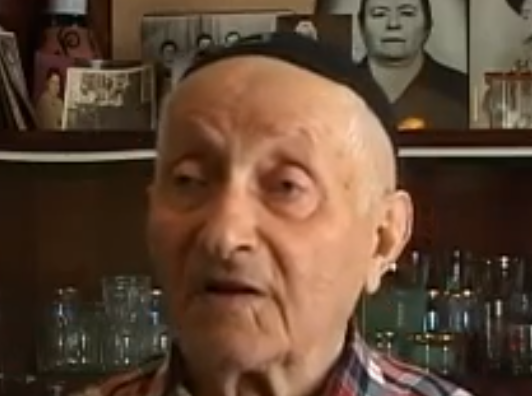
Veniamin Feldman grew up with three siblings. His father, a miller, hired a religious teacher during his childhood. His father was killed by bandits during the Civil War in 1919. Subsequently, he moved to Luhny and attended religious school from 1919 to 1923. As an adolescent, he worked as farmer for Christian families. He was married in 1930. During World War II, he served in the Red Army.
Boots
Ovruch, Ukraine
Veniamin explains in this clip, how a group of bandits took his father to the woods and killed him. Boots were hard to come by in 1919 Ukraine. Even in the north, where almost everyone seemed to work in the felt and leather industries, good winter boots took time and money to obtain.
One day in January 1919, in the midst of the Civil War (1917-1922), Veniamin explained, a “Pole” who had been a warrant officer in the tsarist army and now led a small band of anti-Bolshevik fighters, showed up at their house and demanded leather for boots.
The “Polish” warrant officer was probably Aleksei Kozyr-Zirko, a warlord from eastern Ukraine possibly mistaken for a Pole because of the Galician accent he adopted. For three weeks in December 1918 to January 1919, Kozyr-Zirko reigned over Ovruch and its district, looting Jewish property, stripping Jews of their boots and clothing, degrading and humiliating Jews, and ultimately murdering them with the type of sadistic violence normally associated more with the Holocaust than the pogroms.
The Volunteer Army, commonly known as the Whites, was made up mostly of conservative officers from the tsarist army. They opposed the Red Army's efforts to extend the Revolution and fought for the maintenance of the rights of property owners and priests. During the battles, attacks on the Jews among other minorities, were quite common. One survey counted 688 cities, towns and villages affected by pogroms. Many of these locales suffered multiple pogroms, as armies and brigands came and went. The pogroms were attributed most often to Ukrainian nationalists, though the White Volunteer Army is said to have been responsible for about twenty percent of the attacks, with Veniamin’s father being one example of the latter.
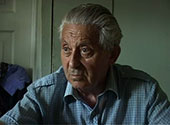
Arkadii Burshtein was born in Sobolivka in 1928. His father was a tailor. He attended a Yiddish school for four years, and then finished his education in a Ukrainian school. He survived in labor camps in the Reichkommissariat Ukraine before making his way into Transnistria. After the war he returned to Haysyn, where he worked as chief engineer in a garment factory.
Other Interviews:
SobolivkaMy Grandfather and the Priest
My Grandfather's Observance
"they wanted us to stay alive."
Speaking Yiddish
The Mass Grave in Sobolivka
Arkadii's Gefilte Fish
Sobolivka Ancedote
Haysyn, Ukraine
Arkadii Burshtein recalls in this clip an episode from the shtetl Sobolivka before World War II. According to him, a sick, albeit sturdy wife bid her husband farewell, before he went off to prison.
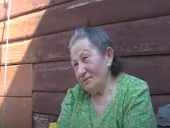
Raisa Turovskaia was educated at a Yiddish school for four years and later graduated from a Ukrainian school. During the war, she evacuated to a kolkhoz in the Shekhmanskii region. She and her family evacuated further to Siberia. She moved to Ovruch in 1944 and worked as History teacher later on.
Other Interviews:
OpenhandedAvoiding Conscription
Childhood Memories
Seeking Help From the Valedniker Rebbe
Ovruch
Raisa Turovskaia recalls in this clip one of her father's stories regarding the wisdom of the Valedniker Rebbe. A married couple sought his help after they lost their baby in the woods.
A rebbe, also called a tsadik, is the leader of a Hasidic community. Turovskaia refers to the Voledniker rebbe as a "tsadik," a righteous person. Tsadikim (plural) were sought out by the community to give advice in spiritual, personal, and business matters. Moreover, rebbes were sometimes said to foresee the future or to be able to see events taking place far away. They often had great insights into the life of other people.
Rabbi Yisroel Dov Ber (1789-1850) – son of Rabbi Yosef of Valednik, author of the book Shearis Yisroel, prominant tsadik and miracle worker, primary disciple of Rabbi Mottel of Chernobyl (source).

Raisa Turovskaia was educated at a Yiddish school for four years and later graduated from a Ukrainian school. During the war, she evacuated to a kolkhoz in the Shekhmanskii region. She and her family evacuated further to Siberia. She moved to Ovruch in 1944 and worked as History teacher later on.
Other Interviews:
Seeking Help From the Valedniker RebbeAvoiding Conscription
Childhood Memories
Openhanded
Ovruch, Ukraine
Raisa Turovskaia describes in this clip her mother’s chief role in collecting charity for the sick, poor, and community members in trouble. Raisa particularly remembers that her mother sent foodstuff to a sick woman in Valednik, as well as collected money from the community.
The Jewish communal support system in the prewar shtetl or village was often the only welfare system Jews in Ukraine and other places in Eastern Europe could count on. Before and after the war, charity constituted a central role to guarantee the continuation of everyday life.

Raisa Turovskaia was educated at a Yiddish school for four years and later graduated from a Ukrainian school. During the war, she evacuated to a kolkhoz in the Shekhmanskii region. She and her family evacuated further to Siberia. She moved to Ovruch in 1944 and worked as History teacher later on.
Other Interviews:
Seeking Help From the Valedniker RebbeOpenhanded
Childhood Memories
Avoiding Conscription
Ovruch, Ukraine
Raisa Turovskaia shares more miracle stories about the Valedniker Rebbe and reveals the tsadik’s wisdom. In the first clip, Raisa describes how a violent son wanted to avoid conscription into the Imperial Russian Army. He therefore sought the rebbe's help together with his mother.
Tsar Nicholas I issued the Statute on Conscription Duty on August 26, 1827. Accordingly, all Russian males between the ages twelve and twenty-five were required to serve in the Russian Imperialist Army for twenty-five years. This decree naturally included the Jewish population. As a result, many Jewish families emigrated from the Russian Empire to avoid military service for their sons.
In the following clip, Raisa explains the desperate situation of a divorced woman, whose husband went off to Siberia and remarried a non-Jewish woman. She lived in poverty and was under great distress to organize weddings for her four daughters. After the woman sought help from the Valedniker Rebbe, everything worked out for the good.

Raisa Turovskaia was educated at a Yiddish school for four years and later graduated from a Ukrainian school. During the war, she evacuated to a kolkhoz in the Shekhmanskii region. She and her family evacuated further to Siberia. She moved to Ovruch in 1944 and worked as History teacher later on.
Other Interviews:
Seeking Help From the Valedniker RebbeOpenhanded
Avoiding Conscription
Childhood Memories
Ovruch, Ukraine
Raisa Turovskaia remembers in this clip, how she and her family celebrated Passover during her childhood. In particular, Raisa emphasizes that her family cooked meat in kosher Passover dishes. The family’s cow, moreover, gave milk enough to sell to neighbors and to donate to the hospital.
Raisa describes in the clip below, how her mother was infected with tuberculosis during the Civil War. Raisa recalls that her mother suffered long-term from the disease. As a result, Raisa had to run chores and take care of the household during her school education.
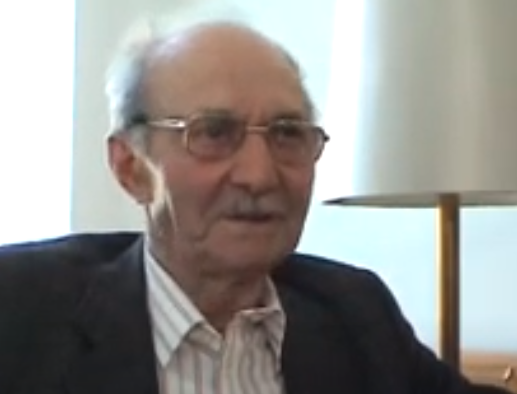
Eugen Grunfeld grew up with five siblings and his father was a merchant. After he attended religious schools in Zau Mureş and Bukarest, he studied at a Romanian school in the city. During the war, he was a forced laborer and worked at the Tighina fortress among other places in Romania. After the war, he moved to Cluj-Napoca, where he was married in 1949. He worked as chief trained cellulose insulation technician at a factory for thirty-five years.
Studying Khimesh Dilemma
Cluj-Napoca, Ukraine
Eugen reveals in this clip, how he spent his Sabbath afternoons growing up. While other children played outside, his grandfather quizzed him about his Talmud (Khimesh) knowledge. In addition to private sessions at home, Eugen attended a public and then private religious school. Eugen thus underwent a thorough religious education before his bar mitzvah.
Jewish boys would traditionally learn how to read Hebrew and study the Torah at the age of 5 in cheder, an elementary school for the study of Jewish texts. The religious teacher (melamed) would then instruct Mishnah at the age of 7, before moving on to Talmud study. Engaging in these complicated religious texts as child, it is understandable that Eugen rather played with his friends on a Saturday afternoon than revise with his grandfather.

Bura Cohn 's parents were also born in Suliţa and he grew up with two brothers. He was an active member of the Zionist youth group Dror Habonim before the war. He and his father spent the war years as forced laborers in Tiraspol, before they were liberated by the Red Army. He was then trained as carpenter and glazier.
Hauling Stones
Botoşani, Romania
Bura Cohn remembers in this clip, how he suffered under forced labor during the war. He and his father worked in a stone quarry and paved roads without much food and very little sleep.
Bura experienced his war years under Romanian command in Tiraspol. Romania became an ally of Nazi Germany in 1940 under the fascist dictatorship of Ion Antonescu. Romanian armed forces, for instance, controlled Transnistria and guarded the Pechera concentration camp. Bura like many others suffered from starvation and endured the war years in miserable living conditions.
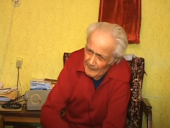
Abram Sharhorodskij ’s parents were also born in Rîbniţa. He grew up with two brothers and one sister. He first attended the local Yiddish school for seven years and then graduated from a Russian school. He was then trained as carpenter. During the war, he was imprisoned in the Rîbniţa ghetto from 1941, until he escaped in 1944. He was a forced laborer in a German hospital next to the ghetto. After his escape, he was drafted into the military and served from 1944 until 1947. He worked as tradesman for forty-five years.
The Ribnitser Rebbe
Rîbniţa , Moldova
Abram Sharhorodskij recalls the significance of Chaim Zanvl Abramovitsh, also known as the Ribnitser Rebbe, a mystic and Jewish religious leader active in Rîbniţa during and after the war. Abram describes how Abramovitsh, respected for his erudition and generosity towards the town's Jews, stewarded the community "like G-d himself" in the postwar period. Abram also tells how Abramovitsh fared in the Rîbniţa ghetto set up by the Romanians during the war. While Abramovitsh, according to Abram, was initially included in forced labor round-ups in the ghetto, he was later hidden by Bessarabian Jewish families in the ghetto and spared from this harsh treatment.
The figure of Chaim Zanvl (c.1890-1995) is mentioned in a number of AHEYM interviews. Famed as a wonder worker, healer, and teacher, he was revered by many Jews and some non-Jews in the region for his role in preserving and transmitting religious traditions in the postwar Soviet Union. After several decades facilitating clandestine spiritual activities in Moldova and Ukraine, Abramovitsh left the USSR in the early 1970s, eventually settling in the United States. Although he passed in 1995, Abramovitsh continues to grow in renown, especially in Hasidic circles where he is known as the Ribnitser Rebbe. His grave, a site of pilgrimage and a place credited as the source of miracles, is located in Monsey, NY.
Sebastian Schulman
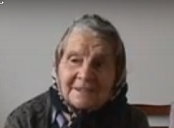
Malka Altman grew up with three siblings and lived in Pervomaiscoe, Moldova, before the war. Her parents were also born in Bălţi (Belz). She never went through formal schooling and was trained as tailor. She spent the war years in evacuation. After the war, she worked at a fur factory and raised two children.
The Shtefaneshter Rebbe
Bălţi, Moldova
Malka Altman retells her husband’s experience during the First World War. As a herdsman in charge of supplying meat for the troops, he passed through Ştefăneşti. Encouraged by a non-Jewish woman, he sought out the Ştefăneşti rebbe. According to Malka, her husband joined the famous tish and stayed overnight. Malka's husband was not a herdsman per se. Rather, he was supposed to ask civilians to volunteer cattle to the Army. After his visit to the Rebbe, Malka's husband continued traveling on this mission in the hinterland. For some reason, it became impossible to hand the cattle over to the Army and the war fighting ended in the meantime. The Rebbe's prediction was thus fulfilled.
Malke uses the impersonal construction throughout her description of her husband's visit to the Rebbe, even when she is most likely referring to the Rebbe himself. For example, she says, "one shook his hand" or "one told him that he won't see the front anymore." Malka perhaps does not refer to the Rebbe directly out of respect. However, when Malka makes the Rebbe's promise more concrete, she slightly raises her voice to convey a direct quotation.
The town of Ştefăneşti in Romania was home to an influential Hasidic dynasty, which lasted from 1851 to 1933. Malka’s husband encountered Rabbi Avrohom Mattisyohu Friedman, whose legacy made Ştefăneşti one of the most important Hasidic centers in Eastern Europe. When the rebbe's followers joined him for tish (a meal or other joyous gathering around the rebbe), he was known not to speak, but to create an awe-inspiring atmosphere. He was also well-known for his miracle work revered by Jews and Christians alike.
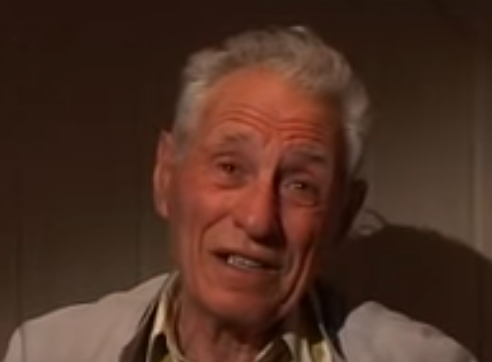
Boris Dorfman lived in Chişinău until the beginning of the war. Both of his parents were imprisoned under Soviet occupation in 1940. He grew up with one sister, who was killed in the Chişinău ghetto. He attended religious school and then a Zionist primary school for four years, before he graduated from a Romanian secondary school. Soon after he finished a technical college to study construction, he was drafted into the Red Army. He spent the war years in the military, before he was sent off to Siberia as forced laborer. He worked as coachman until the war ended. He returned to Chişinău in 1946 and continued his studies. He worked as chief engineer at a factory for thirty-five years.
“they didn’t want to let me go”
Lviv, Ukraine
Boris Dorfman remembers his war years in the Red Army and then under forced labor in faraway Siberia. Instead of pointing out the hardships he inevitably endured as soldier and gulag inmate, Boris addresses his achievements. He proudly describes his leadership positions in the Red Army and later - to the point that his supervisor did not want to discharge him after the war had ended.
Boris Dorfman lived in a territory that came under Soviet control as part of a non-aggression pact signed by Nazi Germany and the Soviet Union in 1939. As Boris describes, Soviet troops retreated from the Moldovan Socialist Soviet Republic, established in 1940, when the German front drew closer. The Red Army fully liberated the region by August 1944. Many locals in this territory, as well as other areas occupied by German troops or their allies, were deported to Siberia and Central Asia in fear of infiltration.
Boris is one of the most prominent and highly respected Yiddish and Jewish cultural activists in today's Ukraine. He was particularly active in the dwindling Yiddish cultural scene during the late 1980s. He became prodigiously active in the revival of Jewish life in and around Lviv in the 1990s and helped to provide care and social sustenance to elderly and often lonely Jews. Boris also has been active in disseminating Yiddish language and culture among young people, most of whom happen to be non-Jewish Ukrainians. A new Yiddish-language Polish documentary film about his life was released in 2014. The AHEYM team interviewed Boris several times, including May 2015.
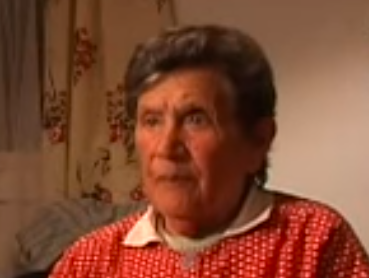
Frida Zak grew up with five siblings. She lost her grandmother during the Great Famine (Holodomor) in 1933. She attended a Yiddish school for ten years and then worked in a Jewish orphanage in Letychiv. During the war, she escaped to Miropol, where her family managed to get on the last local evacuation train to Central Asia. In evacuation, her father died of starvation in 1942. She returned to Polonne in 1944 and worked for two years in the same building, which became a Ukrainian orphanage during the war. Until her retirement in 1988, she worked in a library that she helped to set up.
Other Interviews:
When Peretz Markish Came to PolonneWith the Last Train
Polonne, Ukraine
Frida Zak remembers her young adult life in a nutshell, including her education, family’s suffering in evacuation and beginnings of a life after World War II. Although this resume of her life does not convey the hardships Frida and her family endured during World War II, her account nevertheless demonstrates her power of endurance and reintegration into society after the war.
In the first days of the war, the Soviet government in Moscow established an Evacuation Council, initially headed by Lazar Kaganovich, the Commissar of Transportation who himself had been born and raised in a small shtetl near Kiev. The Council was responsible for coordinating the orderly relocation of critical industrial and consumer infrastructure from the warzone to the Russian interior, where it was imagined industrial output could be preserved with limited interruption. The Council privileged the evacuation of people and entities that were crucial for the military and industrial needs of the state, singling out engineers, workers in factories critical for industrial and military output, youth fit for military service, and state and party elites. Family members of those individuals fitting into these categories were later added to the list. No specific provisions were made for the evacuation of the rest of the civilian population, and at no point was the evacuation of the Jewish population prioritized, despite the mortal danger Jews who fell under German rule faced. The Council also adopted a scorched earth policy, ordering the destruction of all valuable resources that could not be evacuated, so that the enemy--not to mention the civilians caught under enemy rule--would be deprived of even the most basic necessities.
The lack of official sanction and governmental assistance in preparing for evacuation, though, did not stop hundreds of thousands of Jews from fleeing in advance of the German army. Many Jews were able to evacuate as part of the official evacuation because they were represented among the state and party elite or other categories scheduled for evacuation.
These chosen evacuees were often able to bring along family members and even friends on the special trains allocated for this purpose. As word of the atrocities being committed to the west spread, though, most Jews recognized the necessity of flight and took desperate measures to flee. Those who did not make the official list took what they could and headed east. Many Jews had to use their own initiative to evacuate without government assistance.
Source: Jeffrey Veidlinger, In the Shadow of the Shtetl: Small-Town Jewish Life in Soviet Ukraine (Indiana University Press, 2013)

Frida Zak grew up with five siblings. She lost her grandmother during the Great Famine (Holodomor) in 1933. She attended a Yiddish school for ten years and then worked in a Jewish orphanage in Letychiv. During the war, she escaped to Miropol, where her family managed to get on the last local evacuation train to Central Asia. In evacuation, her father died of starvation in 1942. She returned to Polonne in 1944 and worked for two years in the same building, which became a Ukrainian orphanage during the war. Until her retirement in 1988, she worked in a library that she helped to set up.
Other Interviews:
With the Last TrainWhen Peretz Markish Came to Polonne
Polonne, Ukraine
Frida Zak reminisces about Peretz Markish's very soft hand. When she was about to graduate from Yiddish school, the well-known Yiddish writer came to visit his parents in Frida's hometown Polonne. She fondly remembers how students performed Peretz's poems and songs. According to Frida, everybody danced around the New Year tree until the early morning hours.
Peretz Markish, who was born in 1895 in Polonne, enjoyed a traditional Jewish education. He was drafted into the Russian army during World War I and moved to Ekaterinoslav after his discharge from the military in 1917. Markish initially wrote Russian poetry, before he published poems in Yiddish. Markish’s early poetry was infused with the declarative pathos and the apocalyptic mood. The acclaimed poet relocated several times, first to Kiev and then to Warsaw. In 1926 Markish returned to the Soviet Union, but had spent time in major European cities. He headed the Yiddish section of the Soviet Writers Union from 1939 to 1943. During the postwar Stalinist purges, Markish was arrested and sentenced to death. He was executed on August 12, 1952, along with other well-known Yiddish writers in Moscow. This particular execution ordered by Joseph Stalin, came to known as "Night of the Murdered Poets." Markish was posthumously cleared of all charges (“rehabilitated”) in 1955.![]()

His major works, beside lyrical poetry, comprise epic poems, stories, novels, and drama. These include Di kupe (The Heap, 1921); Tsu a yidisher tentserin (To a Jewish Female Dancer, 1940); Milkhome (War, two volumes, 1948); Trot fun doyres (The March of Generations, 1966), Der fertsikyeriker man (The Forty-Year Old Man, 1978). Markish was also the cofounder of the weekly journal Literarishe bleter in Warsaw in 1924.
Markish’s first book Shveln (Threshholds; see image below) was published in 1919 in Ukraine. Markish’s works can be found on the website of the Spielberg Yiddish Digital Library in the original Yiddish language. The Oyneg Shabes blog by the Yiddish Daily Forward reveals information on the commemoration of Markish’s life and work.
A distinguished group of scholars and admirers of the poet celebrated Peretz Markish's 120th birthday in 2015. For more information take a look at this Yiddish article from the newspaper Forverts.![]()

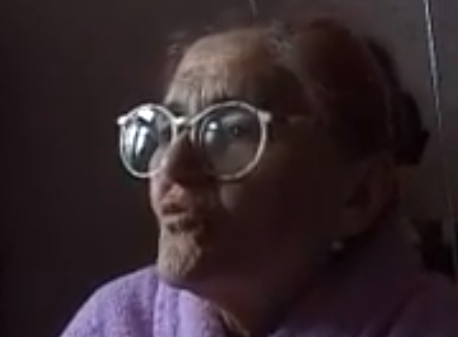
Polina Lebvol grew up with seven siblings. She attended a Polish school in the mornings and then a religious girls' school in afternoons. She began working as seamstress at the age of 13. During the war, she evacuated to the Volgograd region where she worked on a kolkhoz. Her mother and four siblings were killed in Bălţi (Belz). After she returned to her hometown in 1945, she initially worked at the civilian registrar's office and then at a legal office.
The Jewish House
Zhovka, Ukraine
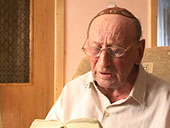
Moyshe Nayman 's parents owned cattle and worked the land during his childhood. He grew up with four siblings and helped out his parents on the farm. His father and grandfather made kosher wine for the community. After he finished his cheder education, he attended a yeshiva in Korsun and then studied with Rabbi Chaim Elazar Spira in Mukacheve. During World War II, he was a forced laborer for a Hungarian labor battalion, before his deportation to the Mauthausen-Gusen concentration camp. He was liberated from the Gunskirchen forced labor camp.
Other Interviews:
Childhood On A FarmMauthausen
Sleeping At Grandpa’s
Klyachanovo, Ukraine
Moyshe Nayman remembers in this clip the sleeping arrangements at his grandfather’s house in the rural village of Klyachanovo, near Mukacheve, before World War II. He and his brother slept in the same straw bed as his grandfather, because there was not room enough for each of the children to have their own beds.
Nayman, who lived on a farm with six cows, also recalls that his family had a vineyard from which they would make kosher wine to sell during Passover.

Vilk Hodinger grew up with five siblings, of whom three perished in Auschwitz. He attended cheder in Vynohradiv from the ages 6 to 15, as well as Czech and Hungarian schools. His father, who worked as laborer, was born in Ilnytsya and his mother came from Pryslip. During World War II, he survived the selection at Auschwitz, where he was deported from the Vynohradiv ghetto in May 1944. He was liberated from the Furstenfeldbruck forced labor camp, where he fixed airplanes for several months. Between 1949 and 1953, he served in the Soviet military. He worked odd jobs before his draft and then sold ice-cream for thirty years.
Other Interviews:
Vynohradiv Ghetto"Hitler ate up our youth"
A Few Pengos
Berehove, Ukraine
In this clip, Vilk Hodinger describes prewar Jewish life in the Transcarpathian town Vynohradiv (Yiddish: Selish). He explains that his family was very poor and his father had to work odd jobs to make ends meet. He also recalls the living arrangements at home, where several members of his family shared a single bed.
Transcarpathia was under Czechoslovak rule when Vilk grew up. Due to the province’s unique location as borderland, a multiethnic population, consisting of Jews, Hungarians, Romanians, Ruthenians, Poles and Germans, resided there. The population cultivated socio-economic ties with neighboring countries that persevered after the province was Sovietized in 1945, and the borders officially shut down. This is why, Vilk’s father was able to make some extra money, specifically pengos - the Hungarian currency between 1927 and 1946, by helping travelers from Budapest with their bags at the railway station.

Vilk Hodinger grew up with five siblings, of whom three perished in Auschwitz. He attended cheder in Vynohradiv from the ages 6 to 15, as well as Czech and Hungarian schools. His father, who worked as laborer, was born in Ilnytsya and his mother came from Pryslip. During World War II, he survived the selection at Auschwitz, where he was deported from the Vynohradiv ghetto in May 1944. He was liberated from the Furstenfeldbruck forced labor camp, where he fixed airplanes for several months. Between 1949 and 1953, he served in the Soviet military. He worked odd jobs before his draft and then sold ice-cream for thirty years.
Other Interviews:
A Few Pengos"Hitler ate up our youth"
Vynohradiv Ghetto
Berehove, Ukraine
In this clip, Vilk Hodiger talks about imprisonment in the Vynohradiv (Selish) ghetto during World War II.
When the Germans occupied Hungary in March 1944--"after Passover," as Hodiger puts it-- they immediately set up ghettos for the Jewish minority.
Most of the Jewish population in Transcarpathia was forced into ghettos. The largest ghettos in the region were in Berehove, Uzhhorod and Khust. Hodiger, who was fifteen years old at the time, was driven out of him home, together with the other children and women of Vinohradiv, and forced into the ghetto. There were few Jewish men in town because in the years before the German occupation, the Hungarian government had already taken most men into forced labor (munka tabor)
Between May 15 and June 7, 1944--"around Shavuot," as Hodiger puts it, once again using the Jewish calendar as a marker-- the Germans deported about 290,000 Jews from Transcarpathia, mostly to Auschwitz.
In Auschwitz, Hodiger was selected for death twice, but explains that somehow someone convinced the authorities to pick him for forced labor instead. He was among the ten percent of Hungarian Jewish deportees, who were sent to concentration camps in Austria and Germany, where they were put to work for the German war effort.
The deportation of 437,402 Transcarpathian Jews was one of the last stages of the Final Solution, and one of its deadliest.
In the following clip, Hodiger speaks about the period after Auschwitz, when he was moved from one concentration camp to the next. He was liberated by American troops near Dachau.

Vilk Hodinger grew up with five siblings, of whom three perished in Auschwitz. He attended cheder in Vynohradiv from the ages 6 to 15, as well as Czech and Hungarian schools. His father, who worked as laborer, was born in Ilnytsya and his mother came from Pryslip. During World War II, he survived the selection at Auschwitz, where he was deported from the Vynohradiv ghetto in May 1944. He was liberated from the Furstenfeldbruck forced labor camp, where he fixed airplanes for several months. Between 1949 and 1953, he served in the Soviet military. He worked odd jobs before his draft and then sold ice-cream for thirty years.
Other Interviews:
A Few PengosVynohradiv Ghetto
“Hitler ate up our youth”
Berehove, Ukraine
Vilk Hodinger talks about his military service in this clip. Hodiger was drafted into the Red Army in 1949, just five years after his liberation from a Nazi forced labor camp near Dachau, Germany. As was the case for many survivors, particularly those who returned to the Soviet Union, the end of the war did not translate directly into a peaceful reintegration into civilian life. Hodiger was drafted into an aerodrome construction regiment as a sapper, and was sent first to Belarus and then to the Soviet Far East. "I traveled across all of Russia," he recalls. In the army with him were a few other Jews who, like him, had only just been liberated from the camps a few years earlier.
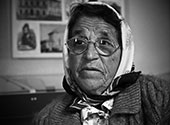
Sura Bivson was born in 1926 in Polonne. Her father paved clay floors. Sura attended a Yiddish school for six years. In 1941, her family escaped from Polonne and evacuated to Birobidzhan. After the war in 1945, Bivson returned to Polonne, and a few years later, her family moved to Starokostyantyniv, where she was married and had one son. Bivson worked as a telephone operator for forty years.
Other Interviews:
the shoykhet across from usBirobidzhan in 1941
Starokostyantyniv, Ukraine
Sura Bivson remembers in this clip the strenuous journey, she experienced as as a child in 1941. Sura and her family evacuated to Birobdizhan, where her sister lived.
After Sure and her family arrived in the Jewish Autonomous Oblast, life was "not too smooth either," as she explains in this clip.

Sura Bivson was born in 1926 in Polonne. Her father paved clay floors. Sura attended a Yiddish school for six years. In 1941, her family escaped from Polonne and evacuated to Birobidzhan. After the war in 1945, Bivson returned to Polonne, and a few years later, her family moved to Starokostyantyniv, where she was married and had one son. Bivson worked as a telephone operator for forty years.
Other Interviews:
Birobidzhan in 1941the shoykhet across from us
Starokostyantyniv, Ukraine
In this clip, Sura Bivson remembers how her family would keep kosher in Starokostyantyniv after World War II. She explains that they continued to procure kosher meat from the neighboring town of Khmelnytskyy, after the local kosher butcher passed away.
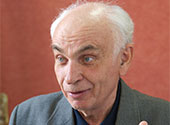
Alexander Cherner Alexander Cherner was born in 1935 in Balta. He comes from a family of klezmer musicians, and has written some 500 klezmer tunes. He lived in Balta until 1952 and then moved to Kharkiv, where he worked as turner and locksmith at a factory. He moved to Odessa in 1961.
Playing Fiddle with my Grandfather
Odesa, Ukraine
In this clip, Alexander Cherner remembers fondly how he performed with his grandfather at a Jewish wedding in Balta around 1948.
Cherner comes from a long line of klezmer musicians, as was common for klezmer musicians. His grandfather led a klezmer group and taught students how to play the piano, clarinet and trumpet before the war. The musical profession was widespread in the shtetl before World War II. Jewish musicians often struggled and had to take on additional jobs to make ends meet. Cherner recalls that most musicians were Jews, but that there were also non-Jews who could play well.

Miron Endelshtein was born in 1925 in Belgorod-Dnestrovskiy (formerly Akerman, Bessarabia). He spoke extensively about his service in the Red Army during the war, in which he used the name Mironov, so that people wouldn't know he was Jewish.
“a memorial plaque”
Mykolayiv, Ukraine
In this clip, Miron Endelshtein speaks about his return to Bolhrad after the war in search of surviving family members. He explains that he heard from a local about the cruel ways in which Jewish children were murdered in the chicken slaughterhouse, and so came to the conclusion that there was nothing left in the town for him. He says he put a memorial plaque up in the synagogue, which has since been turned into a church, and left.
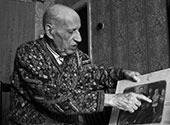
Moisei Fish " was born in March, 1922 in Rivne. His father was known as Zalmen der Miler (b. 1883 in Koloniya Olizarka), since he worked as a house-builder and brick-layer. His mother, Khaye bas Yoyne, was born in 1887 in Zholuds'k, a nearby town. The family moved to Rivne at the start of World War I in 1914. Fish's mother was a housewife and raised the family's five children, of whom Moisei was the youngest. This whole family was killed in the early years of World War II, as were most of the approximately one hundred relatives Fish had before the war. Fish started going to a kheyder (religious school for young boys) at 3.5 years of age and continued until age five. At the age of five-six years, Moisei's father got him a private teacher, who for an hour a day in the afternoon would teach him how to pray. At the age of seven, he began to attend a ""shule"", a Polish-language Jewish school, and continued for seven years. After 7th grade, at the age of thirteen, Fish entered a Polish-language Jewish gymnasium, which he finished in 1939, three months before the war. In the 1930s, Fish participated in Shomer Akiva, a socialist youth group. After graduating from the gymnasium, Fish worked for two months until the war broke out . When the war started, Fish ran on foot to Kotsk at the former Soviet-Polish border, eventually being able to evacuate to the Russian interior and later to Kazakhstan. There, he worked in rice fields, and then in the bookkeeping office in a Korean kolkhoz. He tried to join the army, but he was sent back because he was a former Polish citizen and did not speak Russian well. He moved to Stalingrad and worked in a war-factory for two months. Finally in 1942 he was mobilized and sent to the front. Fish fought in Belarus, Poland, Germany, where he was wounded in the leg by grenade shrapnel, and the Far East. After the war, he completed a Soviet accounting institute. Fish moved back to Rivne in 1946 and found a job as the head accountant in a restaurant, where he worked until 1982. In 1946, Fish married Ida Lakir, a Jewish woman from Kalinindorf, one of the Joint-supported Soviet Jewish kolkhozes. They had three sons. Fish and his wife prepared to immigrate to Israel, but could not go in the end because of his wife's health. Fish has been involved with the local religious community since 1995, where he serves as a leader/cantor [gabe un khazn]. "
Other Interviews:
a Childhood Ditty"Look, over there is a Jew"
Private Teacher
Rivne, Ukraine
Moisei Fish discusses his primary religious education at a private Cheder. He started school at age three and a half. In particular, Fish remembers his teacher, his melamed, also called a rebbe. He remembers that there were about twenty or thirty people in the class From age five on, Fish's father hired a private teacher to come to his house to provide religious instruction.

Moisei Fish " was born in March, 1922 in Rivne. His father was known as Zalmen der Miler (b. 1883 in Koloniya Olizarka), since he worked as a house-builder and brick-layer. His mother, Khaye bas Yoyne, was born in 1887 in Zholuds'k, a nearby town. The family moved to Rivne at the start of World War I in 1914. Fish's mother was a housewife and raised the family's five children, of whom Moisei was the youngest. This whole family was killed in the early years of World War II, as were most of the approximately one hundred relatives Fish had before the war. Fish started going to a kheyder (religious school for young boys) at 3.5 years of age and continued until age five. At the age of five-six years, Moisei's father got him a private teacher, who for an hour a day in the afternoon would teach him how to pray. At the age of seven, he began to attend a ""shule"", a Polish-language Jewish school, and continued for seven years. After 7th grade, at the age of thirteen, Fish entered a Polish-language Jewish gymnasium, which he finished in 1939, three months before the war. In the 1930s, Fish participated in Shomer Akiva, a socialist youth group. After graduating from the gymnasium, Fish worked for two months until the war broke out . When the war started, Fish ran on foot to Kotsk at the former Soviet-Polish border, eventually being able to evacuate to the Russian interior and later to Kazakhstan. There, he worked in rice fields, and then in the bookkeeping office in a Korean kolkhoz. He tried to join the army, but he was sent back because he was a former Polish citizen and did not speak Russian well. He moved to Stalingrad and worked in a war-factory for two months. Finally in 1942 he was mobilized and sent to the front. Fish fought in Belarus, Poland, Germany, where he was wounded in the leg by grenade shrapnel, and the Far East. After the war, he completed a Soviet accounting institute. Fish moved back to Rivne in 1946 and found a job as the head accountant in a restaurant, where he worked until 1982. In 1946, Fish married Ida Lakir, a Jewish woman from Kalinindorf, one of the Joint-supported Soviet Jewish kolkhozes. They had three sons. Fish and his wife prepared to immigrate to Israel, but could not go in the end because of his wife's health. Fish has been involved with the local religious community since 1995, where he serves as a leader/cantor [gabe un khazn]. "
Other Interviews:
Private Teacher"Look, over there is a Jew"
a Childhood Ditty
Rivne, Ukraine
Moisei Fish not only enjoyed an extensive private religious education, but also absorbed religious culture at home. In this clip, Fish sings a Yiddish-loshn koydesh ditty, which he learned from his mother.
alcohol gives you strength.
Strength is the main thing,
alcohol makes you drunk.
"Ov" is a father,
”keyder" is a tatar.
A tatar is a “keyder,"
”begodim" are clothes.
Clothes are “begodim,"
”khut" is thread.
Thread is “khut,"
”lekhem" is bread.
Bread is “lekhem,"
”Rekhem" is thought.
Thought is “rekhem,"
“ "shmoyno" is eight.
Eight is “shmoyno,"
a dove is “ yoyne."
“ Yoyne" is a dove,
“ Mitsnefes" is a hoist.
A hoist is a "mitsnefes,
a stall is "refes."
"Refes is a stall,
"Moro" is gall.
Gall is "moro,"
a cow is "poro."
"Poro" is a cow,
"boyker" - morning.
Morning is "boyker,"
expensive is "yoyker."
"Yoyker" is expensive,
"Eysh" is fire.
Fire is "eysh,
"bosor" is meat.
Meat is "bosor,"
"mayim" is water.
Water is "mayim,"
let’s all make lekhayim.
Childhood ditties were designed to teach Hebrew words. They include words that were rarely, if ever, used in East European Yiddish. This particular ditty was tremendously popular and recorded in Poland, Lithuania, Transcarpathia and elsewhere.
The master scholar of Yiddish folklore, Yehudah-Leib Cahan, published this ditty in the second volume of his Yidishe folkslider, mit melodien, oys dem folk-moyl gezamlt (Yiddish Folk Songs, with music notes, collected directly from the people) in 1912. More recently a version of the rhythmic song was published on the Yiddish Wiki Library. In 2009, the Hasidic blogger Hirshel Tzig published another version. Moreover, Australian cantor, singer, teacher and entertainer Velvl Lederman performs this ditty in a "Polish" (Central) Yiddish with a poignant and wickedly embittered anti-German addition at the end. This part was added in the wake of the Holocaust.
This ditty was also popular among many Yiddish writers. It was cited by Isaac Bashevis Singer, and Itzik Manger alluded to it in his playfully anachronistic "khumes-shpil" (quasi-Biblical short play) entitled "Inside Noah's Arch".
The following section will illustrate a couple of things: first, how the distinction between Moisei Fish's native dialect and the "standard" whole Hebrew pronunciation of Hebrew words has been preserved; and, second, the text itself will be put in comparison with other recordings.
Fish pronounces the Hebrew words according to standard Eastern Ashkenazi form. Moreover, his pronunciation is based to a large extent on Lithuanian Ashkenazi Hebrew (minus the "ey" for "kholem"), rather than on the "local" Volhynian (i.e.,northern variety of Ukrainian) form. Accordingly, "ov", "begodim", "khut", "moro", "poro", "bosor" rather than those current in his own dialect – "uv", "bgudem", "khit", "muru", "puru" and "buser". The preservation of the first short vowel and the last one in "shemoyno" (rather than the more expected one – "shmoyne") and of the diphthong in the single syllable word "eysh" (rather than the more Yiddishized "esh") also clearly testify to a careful presentation of the so-called "whole Hebrew" pronunciation, i.e. the way Hebrew should be pronounced per se in distinction from the Hebrew words which are an integral and fully integrated component of Yiddish.
Moisei's version has two lines (possibly a trace of larger missing segment) which so far couldn't be found in other extant versions:
Kleyder zenen begodim
Khut iz fudem.
Fudem iz khut,
Lekhem iz broyt.
The rhyme here is not preserved in the first couple (i.e. begodim // fudem, instead of *bgudem // fudem) and the second couple is not much of a rhyme at all (khut // broyt). Other variants have no trace of the "fudem" and "khut" element. Instead they have:
Kleyder zenen bgudem (bgodem)
Royt iz udem (odem)
Odem iz royt
Lekhem iz broyt
Another couple in our version that doesn't rhyme too well is:
Fleysh iz bosor
Mayim iz vaser
This is in all likelihood the result of the following missing lines that can be easily found in other versions:
Fleysh iz boser [whole Hebrew: bo'sor]
Khazer iz oser [kha'zir, o'sur]
Oser iz khazer
Mayim vaser
Judging by some rhymes in other variants, there was not much insistence on the "correct" whole Hebrew pronunciation, as it clearly seems to be the case in Moisei's version. He skips a few lines, but on the whole he preserves his early childhood version. It exemplifies a case of distinguishing between proper Ashkenazi pronunciation of traditional Hebrew, side by side with genuine Yiddish folklore.

Moisei Fish " was born in March, 1922 in Rivne. His father was known as Zalmen der Miler (b. 1883 in Koloniya Olizarka), since he worked as a house-builder and brick-layer. His mother, Khaye bas Yoyne, was born in 1887 in Zholuds'k, a nearby town. The family moved to Rivne at the start of World War I in 1914. Fish's mother was a housewife and raised the family's five children, of whom Moisei was the youngest. This whole family was killed in the early years of World War II, as were most of the approximately one hundred relatives Fish had before the war. Fish started going to a kheyder (religious school for young boys) at 3.5 years of age and continued until age five. At the age of five-six years, Moisei's father got him a private teacher, who for an hour a day in the afternoon would teach him how to pray. At the age of seven, he began to attend a ""shule"", a Polish-language Jewish school, and continued for seven years. After 7th grade, at the age of thirteen, Fish entered a Polish-language Jewish gymnasium, which he finished in 1939, three months before the war. In the 1930s, Fish participated in Shomer Akiva, a socialist youth group. After graduating from the gymnasium, Fish worked for two months until the war broke out . When the war started, Fish ran on foot to Kotsk at the former Soviet-Polish border, eventually being able to evacuate to the Russian interior and later to Kazakhstan. There, he worked in rice fields, and then in the bookkeeping office in a Korean kolkhoz. He tried to join the army, but he was sent back because he was a former Polish citizen and did not speak Russian well. He moved to Stalingrad and worked in a war-factory for two months. Finally in 1942 he was mobilized and sent to the front. Fish fought in Belarus, Poland, Germany, where he was wounded in the leg by grenade shrapnel, and the Far East. After the war, he completed a Soviet accounting institute. Fish moved back to Rivne in 1946 and found a job as the head accountant in a restaurant, where he worked until 1982. In 1946, Fish married Ida Lakir, a Jewish woman from Kalinindorf, one of the Joint-supported Soviet Jewish kolkhozes. They had three sons. Fish and his wife prepared to immigrate to Israel, but could not go in the end because of his wife's health. Fish has been involved with the local religious community since 1995, where he serves as a leader/cantor [gabe un khazn]. "
Other Interviews:
Private Teachera Childhood Ditty
“Look, over there is a Jew”
Rivne, Ukraine
Moisei Fish addresses in this clip religious persecution under postwar Soviet rule. He particularly points out that parents were afraid to speak Yiddish to their children, so they would not be recognized as Jews on the street.
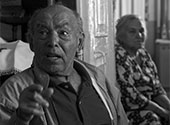
Alexei Futiran was born in Tomashpol in 1925, the son of a coachman. Both his parents were also born in Tomashpol. He was one of six children; two of his brothers died fighting in the Second World War. He attended a Yiddish school for four years, and then completed his education at a Ukrainian language school. At the age of fifteen he began working as a carpenter. During the war he was evacuated to the east, and then drafted into the army in 1943, serving in the Far East until 1950. After the war, he worked as a leatherworker, making hats. He married his first wife in 1950. After she passed away, he remarried a non-Jewish woman. He has two sons, one in Moscow and one in Israel.
a Poor Family
Tomashpil
Alexei Futiran explains in this clip, how he grew up in a poor family. When he was fifteen years old, Alexei began to work as a carpenter apprentice in prewar Tomashpil. Alexei’s family particularly suffered during the Great Hunger (Holodomor) in the early 1930s, when his father was let go from his job as coachman.
Accounts by World War II survivors from Eastern Europe significantly revise the romantic image of the the shtetl. In order to make ends meet, many people had to work on Sabbath, as Alexei addresses in the following clip. Moreover, many men had to take on extra jobs. Many women also worked, in addition to raising children and taking care of the household.
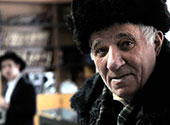
Veniamin Geller was born in 1923 in Pyatka. He has three siblings. Binyomin's father, Yankl, was born in Khazhin, four kilometers from Berdychiv, and his mother in Velyka P'yatyhirka. Geller's father worked in a sugar factory in Gorobtsy and later was a glass-maker in a factory until 1932. When the Great Hunger broke out in 1932, the factory was closed down and Yankl looked for work in Dnipropetrovs'k. However, he fell ill and had to return home in 1934, where he passed away shortly after. Binyomin studied at a Ukrainian school because the Yiddish school was closed in 1930. Geller's family moved to Zhytomyr in 1936. When the war broke out, the family was evacuated to Kazan before the Germans entered Zhytomyr. Geller was drafted in March 1942. He served in the Red Army for four years and was injured three times. He returned to Zhytomyr after the war and got married in 1949.
Other Interviews:
a New LifeThrowing Stones on Kol Nidre
the Great Famine Exodus
Zhytomyr, Ukraine
Veniamin Geller talks in this clip about the effects of the Great Famine of 1932-1933. During the Famine, many artisans fled the village for nearby cities, where conditions were slightly better and where it was sometimes possible to receive support from abroad. With the migration of the artisans, only the poor and elderly Jews were left in Pyatka. A few years later, in 1936, the Yiddish school in the village was closed down. The remaining young Jews left for Berdychiv. By 1939, the Jewish population of the town had fallen from about 500 before the Famine to less than 200. The Jewish community of Pyatka was unable to recover itself after the Famine.

Veniamin Geller was born in 1923 in Pyatka. He has three siblings. Binyomin's father, Yankl, was born in Khazhin, four kilometers from Berdychiv, and his mother in Velyka P'yatyhirka. Geller's father worked in a sugar factory in Gorobtsy and later was a glass-maker in a factory until 1932. When the Great Hunger broke out in 1932, the factory was closed down and Yankl looked for work in Dnipropetrovs'k. However, he fell ill and had to return home in 1934, where he passed away shortly after. Binyomin studied at a Ukrainian school because the Yiddish school was closed in 1930. Geller's family moved to Zhytomyr in 1936. When the war broke out, the family was evacuated to Kazan before the Germans entered Zhytomyr. Geller was drafted in March 1942. He served in the Red Army for four years and was injured three times. He returned to Zhytomyr after the war and got married in 1949.
Other Interviews:
the Great Famine ExodusThrowing Stones on Kol Nidre
a New Life
Zhytomyr, Ukraine
Veniamin Geller remembers in this clip the early beginnings of a new life at the end of World War II. When fighting at the front, Veniamin was injured from a German grenade and almost lost his legs. He recovered at a hospital in Moscow from October 1944 through March 1945 and then returned to Zhytomyr, only to find that gentiles had occupied his home in his absence. With so many Jews murdered and absent from the town, gentile neighbors often assumed that the seemingly abandoned homes were free for the taking. Veniamin managed to reclaim his home, married a Jewish woman in 1949, and settled down to make a new life for himself. His repeated reference to making "a new life" echoes the rhetoric of the time, and signifies the complete rupture that the war represented to so many people.

Veniamin Geller was born in 1923 in Pyatka. He has three siblings. Binyomin's father, Yankl, was born in Khazhin, four kilometers from Berdychiv, and his mother in Velyka P'yatyhirka. Geller's father worked in a sugar factory in Gorobtsy and later was a glass-maker in a factory until 1932. When the Great Hunger broke out in 1932, the factory was closed down and Yankl looked for work in Dnipropetrovs'k. However, he fell ill and had to return home in 1934, where he passed away shortly after. Binyomin studied at a Ukrainian school because the Yiddish school was closed in 1930. Geller's family moved to Zhytomyr in 1936. When the war broke out, the family was evacuated to Kazan before the Germans entered Zhytomyr. Geller was drafted in March 1942. He served in the Red Army for four years and was injured three times. He returned to Zhytomyr after the war and got married in 1949.
Other Interviews:
the Great Famine Exodusa New Life
Throwing Stones on Kol Nidre
Zhytomyr, Ukraine
Veniamin Geller remembers in this clip two episodes from his childhood during the height of the Stalinist anti-religious campaign. In the first episode, he remembers how the prayer house was turned into a carpenter workshop, and one of the assistants mistakenly set it on fire.
In the second episode, he describes how the head of the Ukrainian school, who was himself a Jew, took the children who were members of the Young Communist League (Pioneers) to the synagogue on Yom Kippur in order to throw stones at the faithful on their way to prayer. Teaching children to harass their elders was a common form of Soviet indoctrination and intimidation.
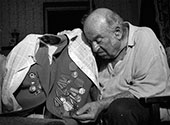
Iosef Grayf was born in Kolomyya in 1922 to parents Gershon and Etl. He had six siblings. Iosef was educated in a Polish-language school and in a "kheyder" (traditional religious school for young boys), where he learned to pray and read and write in Yiddish. Just before the war, Grayf worked on the trains before being drafted into the Red Army. He served in the Far East and on the Eastern front during the Great Patriotic War. After the war, Grayf returned to Kolomyya, where he found no family left. Nevertheless, he decided to stay in the town. After the war, Grayf worked in a dental laboratory. In this photograph, Grayf shows the researchers his jacket covered with war medals.
Other Interviews:
People Stood OutsideReturn to Kolomyya
Around Kolomyya
Kolomyya, Ukraine
Iosef Grayf recalls an active religious life before World War II in his hometown Kolomyya, which was then a part of Poland. In this clip, Iosef Grayf states that Jews were religious not only in Kolomyya but also in the surrounding villages. After being asked, he also comments on the preponderance of small shop keepers among Jews in the city.

Iosef Grayf was born in Kolomyya in 1922 to parents Gershon and Etl. He had six siblings. Iosef was educated in a Polish-language school and in a "kheyder" (traditional religious school for young boys), where he learned to pray and read and write in Yiddish. Just before the war, Grayf worked on the trains before being drafted into the Red Army. He served in the Far East and on the Eastern front during the Great Patriotic War. After the war, Grayf returned to Kolomyya, where he found no family left. Nevertheless, he decided to stay in the town. After the war, Grayf worked in a dental laboratory. In this photograph, Grayf shows the researchers his jacket covered with war medals.
Other Interviews:
Around KolomyyaReturn to Kolomyya
People Stood Outside
Kolomyya, Ukraine
Iosef Grayf recalls an active religious life before World War II in his hometown Kolomyya, which was then a part of Poland. In this clip, Grayf remembers that in the center of town was the Great Synagogue, a layout popular in many other towns in the region, but most people went to the synagogue nearest their own house. He recalls, in particular, the crowds that would gather outside the synagogue, signifying the vibrant religious life of 1930s Poland.

Iosef Grayf was born in Kolomyya in 1922 to parents Gershon and Etl. He had six siblings. Iosef was educated in a Polish-language school and in a "kheyder" (traditional religious school for young boys), where he learned to pray and read and write in Yiddish. Just before the war, Grayf worked on the trains before being drafted into the Red Army. He served in the Far East and on the Eastern front during the Great Patriotic War. After the war, Grayf returned to Kolomyya, where he found no family left. Nevertheless, he decided to stay in the town. After the war, Grayf worked in a dental laboratory. In this photograph, Grayf shows the researchers his jacket covered with war medals.
Other Interviews:
Around KolomyyaPeople Stood Outside
Return to Kolomyya
Kolomyya, Ukraine
Iosef Grayf served in the Red Army during World War II, as he mentions in this clip. After his recovery at a hospital in Perm, Russia, he worked until the war ended in May 1945.
The Jewish population in Ukraine experienced the war very differently. It depended on different occupational forces, which often changed in one place. People who lived in Transnistria were forced into ghettos and the Pechera concentration camp. In the Reichskommissariat territory, Jews were victims of forced labor and widespread massacres. The survival rate was particularly low in this area.
In the following clip, Iosef describes his arrival at home, where he did not meet a surviving family member. He found out that his family was deported to Germany. Iosef continues that life had to go on and he soon made a living. Although many returnees lost their family members, Jewish life was revived and religious customs continued to be practiced.
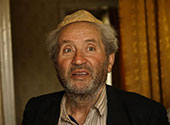
Nukhim Gvinter was born in Bershad in 1936. He is Khayke Gvinter’s brother. He grew up with four siblings. He survived the war in the Bershad ghetto. After the war, he worked as a carpenter in a textile factory and then as the manager of a shoe store. He also served in the military after the war. He has three children.
Other Interviews:
Fixing ShoesHolidays
Bershad, Ukraine
Nukhim Gvinter, Sara's brother-in-law, discusses in this clip holiday celebrations at home in Bershad before World War II. Nukhim proudly points out that his mother knew how to pray.
While Nukhim quickly goes through the most memorable things about major Jewish holidays including Yom Kippur and Passover, his family’s Sabbath rituals are deeply engraved in his memory.

Nukhim Gvinter was born in Bershad in 1936. He is Khayke Gvinter’s brother. He grew up with four siblings. He survived the war in the Bershad ghetto. After the war, he worked as a carpenter in a textile factory and then as the manager of a shoe store. He also served in the military after the war. He has three children.
Other Interviews:
HolidaysFixing Shoes
Bershad, Ukraine
Nukhim remembers in this clip, how his father fixed shoes to support his family in prewar Bershad. Nukhim helped out his father by accompanying him to the surrounding villages or by assisting with repairs at home. This kind of service is entirely obsolete in today’s consumerism and Nukhim’s experience indeed stems from a different century.
Many Jews worked as artisans and merchants in prewar Ukraine and were thus the economic backbone of small market towns (shtetl). The poverty, in which Nukhim spent his childhood, is striking in his description about sharing a piece of bread with his four brothers.
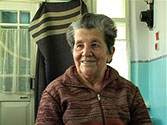
Klara Katsman was born in 1931 in Tulchyn. Her father was a brushmaker and her mother was a homemaker. She has lived in Tulchyn her entire life, other than during the war when she was imprisoned in the Pechera concentration camp. After the war, she returned to Tulchyn, where she worked as a tailor. She has a son and a daughter.
March to Pechera
Tulchyn, Ukraine
Khayke Katsman was a young adolescent, when she experienced World War II under Romanian occupation. In this clip, she describes how the Jewish population of Tulchyn was driven into the local bathhouse for disinfection, suffering unbearable humiliation.
The following clip is the continuation of Khayke’s path to the Pechera concentration camp. While people unable to walk got immediately shot, the prisoners had to spend the night at a stable.
This is the final part of the prisoners’ trajectory from their hometown Tulchyn to the Pechera concentration camp. Khayke remembers how she slept next to corpses that were eventually thrown out and eaten by starving prisoners.
The most striking theme in Khayke's story involves constant lack of basic human needs: water and food. On their way to Pechera, Khayke and others had to drink from trough. In Pechera, inmates were left to their own devices, some even resorting in desperation to cannibalism. Such cases were mentioned also by a few other Pechera survivors, whom we interviewed in Tulchyn.

Roza Klein was born in 1923 in the village Grebenivke. She comes from a highly educated family. Her mother was born in the village Sakhnovtsy and her father was born in the village Hrybenynka and worked as a carpenter. Klein had four siblings. Roza received her education at a Yiddish school where she studied for three grades and which in 1938 was turned into a Russian school with the same teachers now teaching in Russian. Since Klein's father was a specialist, he was evacuated to Omsk (Central Asia) during the war, and the family spent the duration of the war there.
At the Yiddish School
Starokostyantyniv
Roza Klein remembers in this clip her studies at the local Yiddish school in her hometown Starokostyantyniv. In particular, she praises the high quality teaching of subjects, including History and Geography. Interestingly, Roza recalls that the very same teachers, who taught her at the Yiddish school, transferred to the Russians school and continued to teach in the Russian language.
Parents filed numerous contemporary complaints about the poor quality of Yiddish schools and about the low priority they were given in state allocation of resources. The government seemed to have essentially given up on Yiddish schools in the early 1930s, leading to the steep decline in enrollment noticeable after the peak of 1931.
Instead of bolstering Yiddish-language education, the state undermined it. In 1935, the government began closing the Yiddish schools it had opened only a decade before, a process that was accelerated in 1937.
By 1940, there were only about twenty Yiddish schools left in all Ukraine.
Source: Jeffrey Veidlinger, In the Shadow of the Shtetl: Small-Town Jewish Life in Soviet Ukraine (Indiana University Press, 2013)

Riva Medved was born in 1927 in Chernousova, near Vinnytsya. She was in the Balta ghetto during the war.
The Goat
Odesa
Riva Medved recalls a short episode from her childhood memories in Bershad. As a little girl, she went up a snowy mountain to sled. Unfortunately, she happened to be pushed downward by a goat.
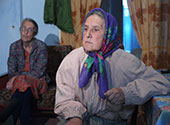
Mira Pasik was born in 1933 in Nikolaev. She grew up on a Jewish kolkhoz (collective farm), Yefingar, where she says that everybody spoke Yiddish and even the Russians on the kolkhoz went to the Yiddish school.The collective farm celebrated all the Jewish holidays and even tried to keep kosher.
Yefingar Colony
Mykolayiv
Mira Pasik remembers her childhood experiences, when growing up in one of the first Jewish agricultural colonies in Eastern Europe, located in the Mykolayivskyy province. When Mira grew up, prewar Stalinist persecution was in full sway. Mira, accordingly, mentions that only one out of three synagogues could still be used for official prayer services. Here is information on the Yefingar colony in Russian.
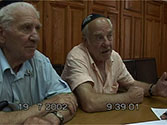
Matvei Rubin was born in 1928 in Buki.
Gefilte Fish
Uman
Matvei Rubin describes in this clip how his mother cooked the well-known Ashkenazi Jewish dish “gefilte fish” (stuffed fish) during his childhood. According to Matvei, it was a laborious undertaking, where the fish had to be chopped with a chopping knife and prepared with beetroot, onion, oil, sugar and matzo meal, resulting in the fish’s stuffing. The dish then had to be cooked on low heat for two hours. In the second part of the clip, Matvei adds more culinary details about his mother’s cooking.
Here are more gefilte fish receipes, recalled by AHEYM informants in the Vinnytsya region.
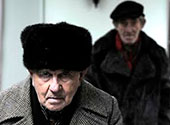
Pyotr Sandler "Perets Shilovich" Sandler was born in Starokostyantyniv in 1926. His father was a barber, and his grandfather was a shoemaker and the head of the Jewish community in Zhytomyr in 1945. Sandler went to a religious school (kheyder), as well as a Yiddish school, which he attended for four grades. During the war, Sandler's family was evacuated to the Volgograd region and later to Uzbekistan. His father died of cholera and was buried in a mass grave there. After the war, the family returned to Starokostyantyniv.
Celebrating Holidays
Starokostyantyniv
Pyotr Sandler fondly remembers holiday celebrations at home. According to Pyotr, his father would make sure that all holidays would be celebrated. Although he grew up in poverty in a family of eight children, they would eat meat once a week, on Sabbath.
Pyotr studied at a Yiddish school for four years and grew up in a traditional home. He cannot, however, recall more details about the holidays themselves. When growing up in prewar Soviet Ukraine in the 1930s, Stalinist persecution of religious activity was at its pinnacle. As a consequence, Jewish religious practice moved underground or was confined to the home. The shift from the public to the private resulted in a less all-encompassing religious education.
Religious schools and state-sponsored Yiddish schools were closed down and thus the development of a Jewish traditional consciousness was often only possible within the family nucleus.
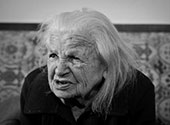
Rakhil Shames was born in 1915 in Ivanopolis (Yanushpol) in 1915. Her father was a millworker. During the war she evacuated to the east and returned afterwards to Khmilnyk. She worked most of her life as a bookkeeper.
Toward Israel
Khmilnyk
Rakhil Shames remembers in this clip an active religious life with an operating synagogue during the aftermath of World War II. According to Rakhil, the majority of Jews left Khmilnyk for Israel later on. This exodus resulted in a drastic shrinkage of the community and therefore less of a possibility to conduct a traditional way of life.
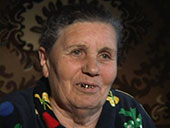
Raisa Teplitskaia was born in 1931 in Ternivke. She grew up with two sisters and one brother. Her father was a blacksmith and her mother was a homemaker and raised pigs. She went to a Ukrainian school. She survived the war in hiding in a village. After the war, she returned to Ternivke, before settling in Uman in 1952. She has three sons, one of whom lives in Germany, and a daughter.
Matzo Baking with Neighbors
Uman, Ukraine
Raisa Teplitskaia remembers her mother's tireless efforts to get everything ready for her family's Passover celebration. In particular, she recalls her parents' and neighbors' combined efforts to bake matzos in their home.
Whereas today matzo is distributed by the Federation of Jewish Communities and is readily available for pickup in Jewish community centers and synagogues throughout the region, acquiring matzo—or more commonly, the flour used to bake it—in prewar Soviet Union was difficult.
Preparations for the Passover holiday often began months before the beginning of the festival, thereby lengthening the sacred time associated with it. Passover was transformed from an eight-day festival into a full season of preparation, culminating in the celebration of the holiday itself. Most people baked matzo themselves at home from flour obtained either in the marketplace, when flour was still available for purchase in the 1920s and early 1930s, or from state stores.
Often foreign currency sent to them by relatives abroad helped smooth the purchase of flour. Others obtained it in November, when it was distributed in commemoration of the October Revolution, and stored it until needed for Passover four or five months later.
Source: Jeffrey Veidlinger, In the Shadow of the Shtetl: Small-Town Jewish Life in Soviet Ukraine (Indiana University Press, 2013)

Grigorii Shor was born in Kopayhorod in 1925. His father was a butcher. He studied for seven years at a Yiddish school and finished his education in a Ukrainian school. He lived in Kopayhorod until he was drafted into the military in 1944. Her remained in the military until 1971.
Other Interviews:
Wooden SynagogueMatzo Baking in the Shtetl
Vinnytsya, Ukraine
In this clip, Grigorii Shor recalls how even after the government confiscated matzo-baking machines in the late 1930s, matzo was still available in Kopayhorod. He explains that it was still possible to obtain matzo from neighboring towns, or several families in Kopayhorod would gather together to bake matzos in their homes. Ironically, the baking of matzo then became a communal experience and its importance was heightened. The rolling pin to poke holes in matzo dough is particularly engraved in his memory.
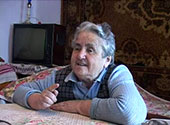
Donia Presler was born in 1929 born in Tulchyn. Her father was a musician. Her mother worked as a glazier. She had two sisters, one of whom died in the Pechera camp. She finished four years of Yiddish school. During the war, she was imprisoned in the Pechera camp for four years.
Other Interviews:
Show Trial in the CampInside the Camp
A Little House with a Dirt Floor
A Family Played the Fiddle
Avrum-Yosl the Glazier
"Christ has risen"
The Torgsin Store
Homentashn
Passover Soup
Tulchyn, Ukraine
Donia Presler recalls her favorite recipe, she remembers her mother preparing for Passover. There are several steps to follow to cook a delicious Passover soup with kugel.
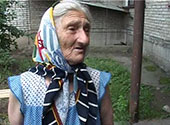
Evgeniia Kozak was born in 1926 in Bershad. She attended a Ukrainian school for eight years. Her parents, who were cousins, were both born in Bershad. Her father was a furrier. She had a younger brother and sister. She survived the war in evacuation in Bezopasnik, Orlovsky Region in the Caucasus and then in Andizhanskaia in the Stalinska region in Central Asia. When she returned to Bershad after the war, in April 1944, her mother worked as a baker. She married in 1958 and has two sons. Her husband died before her second son was born, when her first son was just one and a half years old.
Other Interviews:
A Pair of ShoesFood on Sabbath
Postwar Charity
Evgeniia's Gefilte Fish
Stuffed Neck with Chicken Fat
Bershad, Ukraine
Evgeniia Kozak is excited to share her family recipes with the AHEYM team. In this clip, she explains how a broth only comes out right when you add stuffed chicken neck.
Evgeniia cherishes these foodways all her life, and the memories they instilled were an integral component of her heritage, valued both for gastronomical satisfaction and as a family birthright.
Jeffrey Veidlinger, In the Shadow of the Shtetl: Small-Town Jewish Life in Soviet Ukraine (Indiana University Press, 2013)

Bella Vaisman was born in 1925 in Berdychiv. Her father was born in Warsaw and worked as a chief accountant. She grew up in a relatively wealthy family. Days before the war began, she went to visit her cousin, as a result of which she was cut of from the rest of her family. She survived the war in evacuation in Uzbekistan, but her family was killed in Berdychiv. She was married to Isaak Vaisman.
Other Interviews:
"...and we lived well"Sabbath Was Sabbath
The Reinsdorfs
“a very religious family”
Berdychiv, Ukraine
Bella Vaisman remembers her family's Passover celebration at home in the Jewish town Berdychiv. She points out that she had no brother, who could ask the Four Questions.
The Passover holiday is a domestic affair and is intricately bound up with memories of family and loved ones. Passover was the most observed Jewish holiday in the interwar Soviet Union, as well as the one most condemned by the government. The Jewish Sections of the Communist Party also recognized the popularity of Passover celebrations, and so concentrated much of their propaganda on combating its observance through the use of “Red Haggadahs” and mock trials of Passover.
Passover, like the Sabbath, is remembered today primarily because it evokes memories of family, food, and domestic harmony. Passover’s central rituals — eating matzo, cleaning the house of bread products, and the seder meal — are focused on the home rather than on the synagogue, just as the Sabbath meal and rest are domestic rituals.
Both holidays can be observed in private, inconspicuously, and with few resources. Although both also have a synagogue component, it is the home rituals that define the holiday. Passover was and remains a cherished holiday neither because of its universalist message of liberation nor because of its centrality as one of the three pilgrimage festivals in the Jewish religious tradition, but rather because the unique tastes and smells associated with its specific dietary restrictions evoke a nostalgic longing for childhood.
Source: Jeffrey Veidlinger, In the Shadow of the Shtetl: Small-Town Jewish Life in Soviet Ukraine (Indiana University Press, 2013)
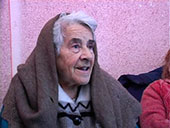
Pesia Kolodenker was born in Tulchyn in 1927. She is the sister of Lev and Aleksandr Kolodenker, as well as the husband of Nisen Kiselman. Her mother was a candy wrapper, before becoming a homemaker. She survived the war in the Tulchyn ghetto and Pechera concentration camp.
Other Interviews:
A Piece of BreadTransport of Corpses
At the Yiddish School
Bris
A Wealthy Family
Tulchyn, Ukraine
Pesia Kolodenker talks about the harsh realities in the Pechera concentration camp, fighting off diseases and starvation on a daily basis. Yet despite dealing with these dreadful extraordinary living conditions, Pesia points out that she, being a young girl, had ordinary thoughts. She describes her encounter with a beautiful Russian-speaking sixteen year-old girl from Bukovina .
A significant part of the clip is in not in Yiddish, as Pesia remembers this episode in the Russian language.

Sara Gvinter was born in 1930 in Bershad. She is a niece of the violinist David Oistrakh. Her father, who died when she was young, was a carpenter, and her mother was a cook. During the Second World War, she was imprisoned in the Bershad ghetto and the Pechera con- centration camp. She was shot by the Germans during a mass shooting outside Pechera, but survived and pulled herself out of a mass grave. She worked for the partisans briefly in the Bershad region. She returned to Bershad after the war, married, and worked as a seamstress.
Other Interviews:
Let It Be Enough!The Synagogue Cellar
Survival
Bershad, Ukraine
Sara Gvinter remembers in this clip one time in 1943 when a German punitive brigade crossed over in black trucks from the other side of the Bug, and massacred a group of Jews. She was among those shot and left for dead in a mass grave. She specifically describes the rounding up and massacring of Nazi camp prisoners, as well as her miraculous survival.
Sara was only ten years old when she witnessed a horrendous scene of mutilation, and thus provides a graphic childlike description. Sara has deep-seated empathy with a tortured boy - Max - who stays ever-present in her memory. Here is a song she remembers Max's father would sing before he was murdered in the Pechera concentration camp. The pain caused by those Nazi atrocities is written all over Sara's face.
Sara's insights have a disturbing effect on the viewer. The horrors of Nazi occupation are mostly unimaginable to post-World War II generations. Sara's account nevertheless takes us a step closer to understanding the gruesome acts committed by Nazis and their collaborators.

Tsolik Groysman 's were also born in Tarashche. His father was a watchmaker and his mother was a homemaker. He grew up with two sisters. He went to a Yiddish school for seven years and then transferred to a Ukrainian school to complete ten grades. A month after the war broke out, he was drafted into the Red Army. He was injured twice in battle, once in Rostov and once in Stalingrad. Before the war, he had studied to become a dentist, but was unable to complete his studies after the war because of his injuries. After he was released from hospital in Tarashche, he took courses to become a massage therapist and started working in the hospital. He then moved to Almaty, where his uncle lived, and started working as a watchmaker, along with his uncle and father. He married a childhood friend from Tarashche and moved to Korsun-Shevchenkivskyy in 1952, where he worked again as a watchmaker.
“forward”
Korsun-Shevchenkivskyy , Ukraine
In the two clips on this page, Tsolik Groysman explains how his belief in God was reinforced by his experiences during the war. He was injured twice, but can only attribute his survival to the intervention of God. In particular, he focuses on one tank battle that he survived for reasons he cannot explain without resorting to the miraculous.
Source: Jeffrey Veidlinger, In the Shadow of the Shtetl: Small-Town Jewish Life in Soviet Ukraine (Indiana University Press, 2013)

Klara Vaynman was born in 1939 in Vinnytsya. She moved to Lviv shortly thereafter. She evacuated to the Urals during the war. Her father was a director of a factory and her mother, born in Lubenets, was a teacher at a Yiddish technical institute. Her father was killed during the war. After the war, her mother worked in a sugar factory and then in the kindergarten in Bar.
Other Interviews:
Women's Prayer Quorum“go there”
Bar, Ukraine
Klara Vaynman addresses in this clip some of the difficulties of starting a new life in the aftermath of World War II.
There were new faces in cities and towns as well, as individuals unable to return to their own homes settled in with their new spouses or wherever they could get a job. Klara Vaynman was born in Vinnytsya, but had been brought up in Lviv before the war. She evacuated during the war to Samara (Kuibyshev), and sought to return to Lviv as soon as the hostilities ended. However, since her birthplace was recorded as Vinnytsya, she was only permitted to travel that far.
Source: Jeffrey Veidlinger, In the Shadow of the Shtetl: Small-Town Jewish Life in Soviet Ukraine (Indiana University Press, 2013)

Brukhe Feldman was born in 1938 or 1939 in Bershad. Her father died fighting in the war when she was three years old, and she was brought up by her mother. She spent much of her life working in a furniture factory.
Other Interviews:
A Gravestone for My MotherHunger of 1946
Kheskele - the Clarinetist
Burial Customs
The Shiva
A Jew Must Eat Matzo
Postwar Religious Practice
Bershad, Ukraine
Brukhe Feldman recalls a couple of episodes from her experience of religious life in the postwar Soviet era, Yom Kippur and Memorial services. In a childlike manner, Brukhe remembers how she thought she was about to get caught eating sweets in the synagogue on Yom Kippur. Upon shofar-blowing, Brukhe felt an ominous presence and therefore didn’t reach into her pocket. Brukhe also amusingly points out that she didn't know shofar-blowing signifies the end of Yom Kippur and fasting.
Insights into an active Jewish communal life in Bershad after World War II draw attention to the fact that religious expression did not only take place within the domestic sphere, but also in form of a continual active synagogue life.
This is particularly interesting for two reasons: it demonstrates the perseverance of the Bershad community to express its Jewish identity vis-à-vis Stalinist antisemitic persecution. It also shows the risk the community was willing to take to pass on their Jewish heritage to the next generation - children that were members of Pioneer and Komsomol organizations. The very fact that children attended synagogue services risked discrimination and repercussions at school.
Brukhe’s reflection indicates that she grew up with a strong sense of Jewish identity. Additionally, Brukhe portrays her mother in both clips as persistent in terms of passing on religious customs to her children. This underlines the community’s perseverance to live an expressive Jewish life after the dramatic experience of World War II.
Brukhe, just a child after the war, doesn’t remember her father, who was drafted when she was only three years old and was killed fighting at the front, but she diligently insists in this clip she honored his memory with the yizkor memorial prayer.

Brukhe Feldman was born in 1938 or 1939 in Bershad. Her father died fighting in the war when she was three years old, and she was brought up by her mother. She spent much of her life working in a furniture factory.
Other Interviews:
Postwar Religious PracticeHunger of 1946
Kheskele - the Clarinetist
Burial Customs
The Shiva
A Jew Must Eat Matzo
A Gravestone for My Mother
Bershad, Ukraine
Brukhe Feldman remembers in this clip the death of her mother by pointing out the help she received from the community .
The Germans vandalized many Jewish cemeteries during the war, stealing gravestones and using them for paving and construction. Once the Red Army arrived, the vandalism continued, as locals made up for the shortage in building supplies by raiding what remained of the Jewish cemeteries.
In the years after the war, local Jewish communities tended to what was left of the cemetery; they sought out toppled gravestones and replanted them on the ground as close to the grave they marked as possible. They carved new gravestones, marking the hundreds—sometimes thousands - who lay in mass graves. Since many of these mass graves lay deep in the woods or in unknown locations, often the Jewish cemetery served as the only available memorial site.
Source: Jeffrey Veidlinger, In the Shadow of the Shtetl: Small-Town Jewish Life in Soviet Ukraine (Indiana University Press, 2013)
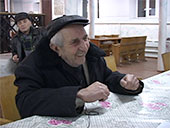
David Soyfer was born in 1930 in Berdychiv. His father, a kosher butcher, was also born in Berdichev and his mother was born in a village near Zhytomyr. He grew up with one brother. During the Famine, he moved to the village to live with his grandmother on a collective farm. In 1939, he returned to Berdichev to live with his father. During the war, he evacuated to the northern Caucasus, and then to Kazakhstan. In 1950, after his return to Berdichev, he was drafted into the Red Army for three and a half years. After his service, he worked as a cooper for thirty-five years. His has one daughter, who lives in Berdychiv.
“make it a synagogue”
Berdychiv, Ukraine
David Soyfer remembers that when returned to Berdychiv from evacuation immediately after the war, the pious prayed outside in the empty courtyard against the synagogue wall.
At times, the needs of the community conflicted with the needs of individuals for shelter and basic necessities. Some sought to rebuild communal life and religious institutions first, whereas others prioritized private housing. Similar debates beset the Soviet reconstruction effort at all levels: most famously, the central government ordered the reconstruction of the tsarist palaces surrounding Leningrad before the population of the city had been provided with adequate housing and hospitals.
On a smaller scale in each and every town that had been destroyed by the war, the local population argued about whether resources would be best allocated toward restoring large symbolic buildings or meeting the more mundane needs of the population.
Source: Jeffrey Veidlinger, In the Shadow of the Shtetl: Small-Town Jewish Life in Soviet Ukraine (Indiana University Press, 2013)

Pesia Kolodenker was born in Tulchyn in 1927. She is the sister of Lev and Aleksandr Kolodenker, as well as the husband of Nisen Kiselman. Her mother was a candy wrapper, before becoming a homemaker. She survived the war in the Tulchyn ghetto and Pechera concentration camp.
Other Interviews:
A Wealthy FamilyTransport of Corpses
At the Yiddish School
Bris
A Piece of Bread
Tulchyn, Ukraine
Pesia recites a song in this clip that she heard from an acquaintance in the Pechera concentration camp. A woman, who lost her six children in the camp, asked for food.
The horrid reality of daily life in a concentration camp, including personal encounters like Pesia's, were intensified by the fact that no one was able to give her anything. The woman therefore passed away soon after. Encounters with acquaintances and strangers in this extraordinary environment haunt survivors their entire lives.
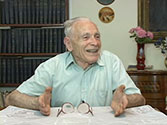
Ernest Halpert was born in 1923 in Mukacheve, which was then under Czechoslovak rule. His father was a shopkeeper and Halpert grew up with two sisters. Halpert attended a private religious school until his bar mitzvah and then worked at a factory until the outbreak of World War II. When Mukacheve was occupied by the Germans in 1944, he was deported to Austria, where he was imprisoned in several camps as forced laborer. In March 1945, Halpert was drafted into the Red Army. During the postwar Soviet era, Halpert worked as engineer at a factory and raised two children.
Other Interviews:
The Hard YearsThe Jewish Soul
The Prayer House
Minkatch: a Jewish Town
Uzhhorod, Ukraine
Ernest Halpert describes in this clip how he grew up in a religious family in Mukacheve before World War II. The romantic image of a Jewish shtetl (i.e., small Jewish market towns) in Eastern Europe that occurs in Western literary and scholarly narratives disappears at once when Ernest mentions his straining job at a factory at 13.
Ernest returned to Mukacheve after World War II, when he was released as forced laborer from the Hungarian Army battalion for Jews. The Transcarpathian province was officially annexed to the Ukrainian Soviet Republic mid-1945. This new socio-political reality significantly restricted Jewish religious practice - as Ernest remembers well. Ernest's strong sense of Jewish identity, growing up in a hasidic family, is very much noticeable when he describes the urge to live a Jewish way of life. After the collapse of the Soviet Union in 1991, he was finally able to practice religion free from state persecution.

Ernest Halpert was born in 1923 in Mukacheve, which was then under Czechoslovak rule. His father was a shopkeeper and Halpert grew up with two sisters. Halpert attended a private religious school until his bar mitzvah and then worked at a factory until the outbreak of World War II. When Mukacheve was occupied by the Germans in 1944, he was deported to Austria, where he was imprisoned in several camps as forced laborer. In March 1945, Halpert was drafted into the Red Army. During the postwar Soviet era, Halpert worked as engineer at a factory and raised two children.
Other Interviews:
Minkatch: a Jewish TownThe Jewish Soul
The Prayer House
The Hard Years
Uzhhorod, Ukraine
Ernest describes in this clip the fate for the majority of Jews from Transcarpathia during World War II. After Passover 1944, all Jews that were assembled from villages and other towns in ghettos of major Transcarpathian towns a month or so prior, were deported to the Auschwitz concentration camp.
By undergoing the same fatal processes of the Holocaust, they joined the destiny of the majority of Eastern European Jews in Auschwitz. It is beyond human imagination, particularly for the younger generations, how Ernest and other Nazi camp survivors are capable of talking about "the hard years" and reflecting on the horrors of Auschwitz. Ernest, like so many others, came to witness the inhumanity that "Auschwitz" represents. Survivors narrate their experiences of Joseph Mengele's selection processes, while smelling burned flesh and seeing smoke coming out of the camp's chimneys.

Nusn Naybauer was born in Velké Kapušany in 1924 and grew up in Mala Dobron. His father worked in an equestrian military facility. Naybauer attended religious school until his bar mitzvah and moved to Uzhhorod in 1935. During World War II, he was imprisoned in the Hungarian forced labor camp Munka Tabor, before being deported to Auschwitz, Gleiwitz and Mittelbau-Dora camps. After the war, he returned home via Prague and Budapest.
Other Interviews:
Bergider and Golda MeirThe Article
Tailored Suits
Uzhhorod, Ukraine
While taking a stroll through the former Jewish neighborhood in downtown Uzhhorod that used to be filled with Jewish artisan shops, Nusn Naybauer talks about his apprenticeship at his uncle’s tailor shop in the very same town, then under Czechoslovak rule. Nusn points out his successful career as tailor, serving customers across Eastern Europe after World War II. During the postwar Soviet period, Nusn - just like many other Jews in the Soviet Union - continued to work in occupations found in any shtetl before World War II. The fact that craftsmanship was passed on from one generation to the next is also a typical shtetl phenomenon.
In this clip, Nusn also points out his great circle of acquaintances, which spanned an area covering Hungary, a Soviet satellite state, all the way to Moscow, the political control center of the USSR. Nusn's connections became particularly important in order to protect his wife, a teacher, from antisemitism at her school. She was asked to write a report and include justification for her son's circumcision.
Nusn's acquaintanceship beyond Soviet borders reveals the Transcarpathian province's unique position as borderland and its role as window to the West in postwar Soviet times. Jewish life in Soviet Transcarpathia also demonstrates that in spite of its annexation to the Ukrainian Socialist Republic (UkSSR) in mid-1945, prewar connections to neighboring countries, like Hungary, persisted after the war.
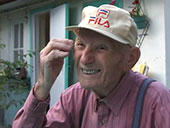
Genrykh Zinger began a tailor apprenticeship at the age of 14 in his hometown Velykyi Bereznyi, then in Czechoslovakia. His father worked as tombstone carver, glazier and frame builder. He was drafted into the Czechoslovak army in 1936 and served for three years. During World War II, he was a forced laborer for the Hungarian army from 1940 to 1943. After the Red Army defeated the Hungarian army, Zinger was captured along with other POWs and sent to a gulag in Voronezh, Russia, where he worked as tailor. He returned to his hometown in 1946, but joined his sister in Uzhhorod soon after.
Other Interviews:
Carving TombstonesCommunal Matzo Baking
From Hungarian to Russian Forced Labor
Uzhhorod, Ukraine
Genrykh Zinger describes in this clip how he endured the harsh conditions of Hungarian forced labor (munkaszolgálat or Munka Tábor) during the winter of 1942. He specifically describes a forced march, fleeing the front and searching for food. It was during this winter when the Red Army prevailed at the battle of Stalingrad, when the Germans were unprepared to fight in those conditions.
Although Zinger was a forced laborer, the Red Army did not make any distinctions regarding ethnicity and treated him, like Hungarian soldiers, as a Prisoner of War. He was therefore sent to a gulag in faraway Russia, from which he returned not before 1946. Genrykh returned to his hometown Velykyi Bereznyi, which became part of the Ukrainian Soviet Republic mid-1945, and found all the borders to neighboring countries cut off. Genrykh was born in the first year of World War I in a region that was under Czechoslovak rule until 1938. Upon his return, Genrykh was confronted with a new Soviet reality.
Grenrykh points out that it is general knowledge to grasp war realities. It is, however, difficult to imagine to cook rotten food remains from compost over a bonfire during a forced labor march in freezing cold.

Genrykh Zinger began a tailor apprenticeship at the age of 14 in his hometown Velykyi Bereznyi, then in Czechoslovakia. His father worked as tombstone carver, glazier and frame builder. He was drafted into the Czechoslovak army in 1936 and served for three years. During World War II, he was a forced laborer for the Hungarian army from 1940 to 1943. After the Red Army defeated the Hungarian army, Zinger was captured along with other POWs and sent to a gulag in Voronezh, Russia, where he worked as tailor. He returned to his hometown in 1946, but joined his sister in Uzhhorod soon after.
Other Interviews:
From Hungarian to Russian Forced LaborCommunal Matzo Baking
Carving Tombstones
Uzhhorod, Ukraine
Genrykh Zinger remembers fondly in his clip, how his father took him out the to large Jewish cemetery of Velykyi Bereznyi. Throughout his childhood, Genrykh assisted his father, who was a skilled artisan in the shtetl. Carving tombstones was more on the creative side, along with making klezmer music, among the Jewish professions in prewar Ukraine. Typical Jewish occupations included merchants, glaziers and tailors. The more artistic professions were often accompanied with a less stable income. Genrykh's father, accordingly, worked as frame builder and glazier during the winter.

Genrykh Zinger began a tailor apprenticeship at the age of 14 in his hometown Velykyi Bereznyi, then in Czechoslovakia. His father worked as tombstone carver, glazier and frame builder. He was drafted into the Czechoslovak army in 1936 and served for three years. During World War II, he was a forced laborer for the Hungarian army from 1940 to 1943. After the Red Army defeated the Hungarian army, Zinger was captured along with other POWs and sent to a gulag in Voronezh, Russia, where he worked as tailor. He returned to his hometown in 1946, but joined his sister in Uzhhorod soon after.
Other Interviews:
From Hungarian to Russian Forced LaborCarving Tombstones
Communal Matzo Baking
Uzhhorod, Ukraine
Genrykh Zinger recalls in this clip how he helped out his father, baking matzos with other families, in his home before Passover. As Genrykh points out, there was no possibility to buy machine made matzos in stores, as nowadays. The Jewish community of Velykyi Bereznyi, therefore, relied on their own strong hands to complete the often week-long matzo baking processes. Jewish communities in prewar Soviet shtetls, like Kopayhorod and Ternivka, also baked shmurah matzos in combined effort that took place in secrecy.
In oral history interviews, informants - like Genrykh - are often glad to receive questions about their childhood. It brings back memories about a distant and seemingly perfect family life. When talking about the past and fate of relatives during World War II, childhood memories are a welcome diversion.
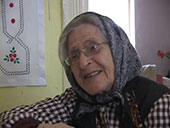
Malke Snook 's father was a farmer. Before the war, she studied at a technical college. She also attended a religious school for three years. She was deported to Auschwitz during World War II. After the war, she raised a child that she was able to rescue from a woman about to be sent the crematory. She raised her son traditionally Jewish and made sure he would attend religious school.
Other Interviews:
Left BehindExtinguishing Coals
Khust, Ukraine
The Slavic folk custom of throwing hot coals into water in order to determine the presence of the evil eye and to remove its effects was widespread among the Jewish population as well. The hissing noise of the coal when thrown into water symbolizes the bursting of the evil eye. It is difficult to establish why healing power is attributed to coal. One explanation could be the cleansing and disinfecting properties of charcoal ash. If the coal sinks, the person is diagnosed with being inflicted with the evil eye. After the coal has sunk to the bottom of the glass, the afflicted person takes three sips of the water, and the person performing the ritual sometimes sprinkles the four corners of the room to ward off or wash away the evil eye.
The practice of finding a remedy for good health or to protect someone from the evil eye [Yiddish: a gut oyg; Hebrew: ayin ha'ra] has been part of Jewish tradition for over a thousand years. It also became a widespread Christian and pagan tradition and was absorbed into Jewish daily life throughout Eastern Europe. Jewish residents would for instance visit Christian neighbors to protect their newborn children from the evil eye. In Jewish towns, or shtetls, other folk customs - involving the practice of folk medicine, such as rolling an egg and drinking urine - were also widespread.

Malke Snook 's father was a farmer. Before the war, she studied at a technical college. She also attended a religious school for three years. She was deported to Auschwitz during World War II. After the war, she raised a child that she was able to rescue from a woman about to be sent the crematory. She raised her son traditionally Jewish and made sure he would attend religious school.
Other Interviews:
Extinguishing CoalsLeft Behind
Khust, Ukraine
In this clip, Malke Snook sings a very sad song about an abandoned lover. Her sweetheart left for Di goldene medine, the Golden Land of America, and had promised to write and keep her in his heart. But as time passes, she waits for the letters that never come.
The song stems from the period of massive emigration from Ukraine in the early twentieth century. Men often preceded their families in emigration with the intention of sending for their families as soon as they got settled. All too often, though, the families were forgotten and the young men, liberated from all the strictures of life in the Old World, chose instead to start a new in America, leaving their families behind. Married women left behind became agunahs, abandoned wives, and were not permitted to remarry without a divorce or proof of their husband's demise. The presence of so many abandoned wives, often with children to care for and no wage-earner, created a large social and economic problem for the Jewish communities in Ukraine and Poland. Sometimes women were impelled to hire private detectives to search out their husbands in America. In this song, the couple is not married, so the deleterious effects of abandonment are limited to heartbreak.
S’iz shoyn fariber dray monat, dray yor
er iz dokh eyn birger atsind,
fun zayn ershter gelibter hot er shoyn lang fargesn,
er hot shoyn eyn froy mit eyn kind.
Un di gelibte tut veynen un klogn,
zi shpayt dokh shoyn nebekh mit blut.
geshribn hot zi im a brivele,
dos lebn on im ken zi shoyn nisht,
as soon as I’ll arrive in America
one letter I’ll write to you at once."
By now three months, three years passed,
he's a citizen by now,
he had long forgotten about his first love,
he already has a wife and child.
And the beloved keeps on crying and lamenting,
she, the poor thing, already spouts blood.
She wrote him a letter,
she can’t go on life without him.
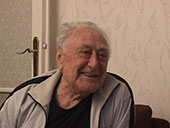
Adolf Smajovics grew up with two brothers and one sister, as well as four half-siblings. He attended cheder at the age of four and began his education at a Czech school in Vynohradiv when he was six years old. His father was a field worker and died in 1926, as result of an accident with his horses. He began a blacksmith apprenticeship in 1939. Before he was a forced laborer for a Hungarian army battalion from 1942 until 1945, he worked as locksmith and blacksmith.
A True “Khosid”
Khust, Ukraine
Malke Snook sings about a hasid’s devotion to his rebbe. The song was popular in the small towns of the Transcarpathian region, where Hasidism was popular. We recorded another version of the song, shared by Adolf Smajovics, who was born in nearby Velyka Kopanya.
un makhn farsheydene havayes.
Un der rebe mit zayne khasidimlekh
geyt zey oys dos khayes. (x2)Hey-hoy rebenyu, ikh shtey un tsiter,
in mayn hertsl brent a fayer.
ikh vel zayn a khosid a guter,
eyn khosid eyn getrayer.A volenem shal vel ikh mir ontun,
zumer in di greste hitsn. (x2)
A langn kaftan vel ikh mir ontun
mit finf-un-zibetsik shpitsn. (x2)
Hey-hoy rebenyu, ikh shtey un tsiter,
in mayn hertsl brent a fayer.
Ikh vel zayn eyn khosid eyn guter,
eyn khosid eyn getrayer.
In der kalter mikve vel ikh mikh toyvlen
vinter in di greste keltn, (x2)
an erlekh yidele vel ikh farblaybn
oy-oy af beyde veltn. (x2)
Oy, I will shokel during prayers
and make different grimaces.
And the rebbe with his hasidim,
[so that] they lose themselves of joy.
Oh yes, my dear rebbe, I stand [before you] and tremble,
a fire burns in my little heart.
I will be a good, devoted hasid
a hasid, a faithful one.
I will put on a woolen shawl,
in the greatest heat of summer.
I will put on a long black coat
with seventy-five laces.
Oh yes, my dear rebbe, I stand [before you] and tremble,
a fire burns in my little heart.
I will be a good, devoted hasid,
a hasid, a faithful one.
I will immerse in the cold mikveh
in the greatest cold of winter.
I will remain a pious Jew
oy, oy in both worlds.
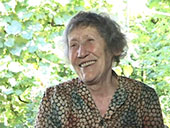
Perl Nayman 's father was a Cohen and worked as a blacksmith. She grew up with five brothers and one sister. She and her mother helped non-Jews work the fields with their horse during her childhood years. Her family owned a plot of land and animals. She listened in classes at a cheder in Turya-Bystra. She was deported to Auschwitz in April 1944. Afterward, she was forced to work at a metal factory and then to build trenches in Germany, before her liberation by the Red Army troops in May 1945. After the war, she lived in Studenyy for thirty years, before moving to Vynohradiv in 1978.
Other Interviews:
Selection at AuschwitzA Child Lost To The Evil Eye
“Let her pray”
Vynohradiv, Ukraine
Perl Nayman describes in this clip how she snuck into the boys' cheder without paying. After the melamed (religious teacher) saw how serious of a student she was, he allowed her to sit in and pray together with the boys.

Perl Nayman 's father was a Cohen and worked as a blacksmith. She grew up with five brothers and one sister. She and her mother helped non-Jews work the fields with their horse during her childhood years. Her family owned a plot of land and animals. She listened in classes at a cheder in Turya-Bystra. She was deported to Auschwitz in April 1944. Afterward, she was forced to work at a metal factory and then to build trenches in Germany, before her liberation by the Red Army troops in May 1945. After the war, she lived in Studenyy for thirty years, before moving to Vynohradiv in 1978.
Other Interviews:
"Let her pray"A Child Lost To The Evil Eye
Selection at Auschwitz
Vynohradiv, Ukraine
Pearl Nayman explains in this clip how she, at the age of 18, survived selection in Auschwitz in April 1944. She explains that she pretended her younger cousin was her child in the hopes that she would be kept together with her family, but the Germans separated her from her family, sending her to the labor camp and the rest of her family to the crematoria.

Perl Nayman 's father was a Cohen and worked as a blacksmith. She grew up with five brothers and one sister. She and her mother helped non-Jews work the fields with their horse during her childhood years. Her family owned a plot of land and animals. She listened in classes at a cheder in Turya-Bystra. She was deported to Auschwitz in April 1944. Afterward, she was forced to work at a metal factory and then to build trenches in Germany, before her liberation by the Red Army troops in May 1945. After the war, she lived in Studenyy for thirty years, before moving to Vynohradiv in 1978.
Other Interviews:
"Let her pray"Selection at Auschwitz
A Child Lost To The Evil Eye
Vynohradiv, Ukraine
In this clip, Pearl Nayman discusses the death of her first child, which she blames on a sorceress who visited her house and gave the newborn the evil eye.
Superstitions about the evil eye were widespread among Jews and Christians alike in early twentieth-century Eastern Europe, and remain common today. Nayman believes that some people possess the power to bewitch and do harm by spiteful looks. She explains that she only learned later that the evil eye can be warded off by extinguishing coals, and regrets not having extinguished coals after the sorceress visited her newborn.
In the next clip, Nayman explains the process of extinguishing coals to ward off the evil eye. She explains that first, you put hot coals into a cup of water. Then you count to nine, but adding "not" before each number, first forwards and then backwards. Next you wash the child with the water, and then wipe it off a certain way while reciting "May all evil fall off of you."

Dora Fiksler 's parents were born in Romania and owned animals, when she grew up. Her father was a construction worker. She grew up with six siblings and helped out with the animals in her free time. She attended a Hungarian school for eight years. During the war, she was initially deported to Auschwitz and then further to the Mauthausen concentration camp. There she worked at a factory until her liberation. After the war, she worked as shop assistant in a grocery store in Solotvyno.
Other Interviews:
After The WarYiddish and Hungarian
A Neolog Family
Solotvyno, Ukraine
Dora Fiksler describes her religious upbringing in Transcarpathian Nyzhnye Solotvyno. When she was born in 1924, the town belonged to Czechoslovakia but like most of Transcarpathia, had long been a part of Hungary. As a result, Fiksler's upbringing was Hungarian in orientation. She speaks a Hungarian inflected Yiddish and identifies her family as having been Neolog, a reformed version of Judaism followed by most Hungarian Jews. Her comment that her grandfather from Romania was Orthodox but her own father was already Neolog, can also be seen as part of a general trend that Romanian Jews were more orthodox and that levels of orthodoxy decreased with each passing generation.

Dora Fiksler 's parents were born in Romania and owned animals, when she grew up. Her father was a construction worker. She grew up with six siblings and helped out with the animals in her free time. She attended a Hungarian school for eight years. During the war, she was initially deported to Auschwitz and then further to the Mauthausen concentration camp. There she worked at a factory until her liberation. After the war, she worked as shop assistant in a grocery store in Solotvyno.
Other Interviews:
A Neolog FamilyYiddish and Hungarian
After The War
Solotvyno, Ukraine
A vibrant and diverse Jewish life characterized Dora Fiksler's hometown of Nyzhnye Solotvyno before the war, when it was under Czechoslovakian sovereignty. But after the war, the region fell under Soviet rule and was subject to Soviet anti-religious campaigns. Only about ten percent of the prewar Jewish population returned to the town. The Soviets confiscated the synagogues, claiming that there were too few Jews left to warrant their use, and the few Jews who remained in the town gathered in private homes for prayer services.

Dora Fiksler 's parents were born in Romania and owned animals, when she grew up. Her father was a construction worker. She grew up with six siblings and helped out with the animals in her free time. She attended a Hungarian school for eight years. During the war, she was initially deported to Auschwitz and then further to the Mauthausen concentration camp. There she worked at a factory until her liberation. After the war, she worked as shop assistant in a grocery store in Solotvyno.
Other Interviews:
A Neolog FamilyAfter The War
Yiddish and Hungarian
Solotvyno, Ukraine
Although Nyzhnye Solotvyno was a mixed Hungarian and Jewish town before World War II, Dora Fiksler recalls that the two populations remained largely separate. The Czechoslovak state, to which Nyzhnye Solotvyno belonged, tried to integrate the populations in school, but Fiksler recalls that most of her friends were still Jewish. Even when the Jews spoke Hungarian, there were still social barriers between the Jews and the Hungarians. As Fiksler concludes, "The Jewish girls went for walks on Saturday; the Hungarian girls went on Sunday."
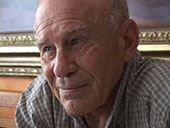
Hershel Vider grew up with three brothers. He attended cheder and spoke with his parents in Hungarian and with his grandparents in Yiddish. As an adolescent, he was involved in Zionist movements, such as Betar and Hashomer Hatzair. During the war, he was imprisoned in a Russian labor camp in Vorkuta,Russia, from which he was released in 1946. He was married in a traditional wedding in 1949.
Other Interviews:
Coming HomeVorkutlag
Bubbie Zisl
Mukacheve, Ukraine
In this clip Hershel Vider talks about his great-grandmother, who died in 1927, when Hershel was only a child. He remembers, though, that every evening she would have a dinner of two rolls from the nearby bakery and a glass of red wine. He proudly states that his family has lived in Mukacheve for several hundred years.
Mukacheve was what some have called a typical Jewish town in Transcarpathia under Czechoslovak sovereignty; its Jewish population was about sixty percent of the total population of the city. Not only was it a center for Hasidism, led by Rabbi Chaim Eleazar Spira, but it was also housed one of the best Hebrew gymnasiums east of Budapest.

Hershel Vider grew up with three brothers. He attended cheder and spoke with his parents in Hungarian and with his grandparents in Yiddish. As an adolescent, he was involved in Zionist movements, such as Betar and Hashomer Hatzair. During the war, he was imprisoned in a Russian labor camp in Vorkuta,Russia, from which he was released in 1946. He was married in a traditional wedding in 1949.
Other Interviews:
Bubbie ZislVorkutlag
Coming Home
Mukacheve, Ukraine
Hershel's brother only spent three days in Mukacheve, after his return in May 1945. It was a common phenomenon among Transcarpathian Jewish returnees to leave the region, as soon as they came to know that no one from their family survived. In addition to this, the new Soviet rule was also a good reason for people to leave.
Hershel, however, did not have a choice, as he points out in this clip. He was sent to a gulag in 1940, after being accused of spying. Hershel was only released in 1946 and was forced to reside in Transcarpathia. The Soviet border was sealed after December 31, 1945.
The dwindling postwar population in Transcarpathia was connected with two emigration waves; immediately after World War II and in the 1970s. There were, however, a number of Jewish migrants from other parts of Ukraine, as well as Russia, that enriched local populations.
The prospects for a Jewish life in Transcarpathia after World War II looked grim. Over seventy percent of the prewar population was killed in Auschwitz, many died during forced labor or death marches, as well as in ghettos. The majority that managed to survive the war ended up leaving Transcarpathia.
Yet, a few thousand Jews came back and stayed. They rebuilt communities and fostered an active religious practice vis-à-vis persecution. As a result, we can find revived traditional communities in many towns, especially Mukacheve. Hershel remembers in this clip, how he helped baking matzos at a Romanian migrant’s home.

Hershel Vider grew up with three brothers. He attended cheder and spoke with his parents in Hungarian and with his grandparents in Yiddish. As an adolescent, he was involved in Zionist movements, such as Betar and Hashomer Hatzair. During the war, he was imprisoned in a Russian labor camp in Vorkuta,Russia, from which he was released in 1946. He was married in a traditional wedding in 1949.
Other Interviews:
Bubbie ZislComing Home
Vorkutlag
Mukacheve, Ukraine
Over seventy percent of Transcarpathian Jewry was killed in Auschwitz. A minority of the prewar population of 102,000 individuals, however, managed to survive either in hiding or in forced labor camps, sometimes under Hungarian direction and sometimes under Russian direction. In this clip, Hershel Vider explains how he survived the war in the Vorkuta gulag, where he was sent at age 18. He jokes that he was accused of being a spy for the Yiddishists. It was in the gulag, he explains, that he learned to speak Russian. In the clip below, Vider describes the fate of the rest of his family: two brothers were in Auschwitz, one brother was in hiding in Budapest and was saved by Raoul Wallenberg, and the fourth brother fought in France as part of a brigade of volunteer exiles from Czechoslovakia, calling themselves the "Masaryk Czechoslovak Regiment."

Moyshe Nayman 's parents owned cattle and worked the land during his childhood. He grew up with four siblings and helped out his parents on the farm. His father and grandfather made kosher wine for the community. After he finished his cheder education, he attended a yeshiva in Korsun and then studied with Rabbi Chaim Elazar Spira in Mukacheve. During World War II, he was a forced laborer for a Hungarian labor battalion, before his deportation to the Mauthausen-Gusen concentration camp. He was liberated from the Gunskirchen forced labor camp.
Other Interviews:
Sleeping At Grandpa'sMauthausen
Childhood On A Farm
Klyachanovo, Ukraine
In this clip, Moyshe Nayman remembers the rural environment of his childhood in prewar Klyachanovo, a village near Mukacheve. It was common for Jewish families to settle in villages near large towns so that they could utilize the Jewish communal infrastructure of the larger city, such as its cemetery, mikvah and synagogue. Despite the preponderance of Jews as urban dwellers, many Jews lived in smaller villages, where they could own land and live off the land.
Nayman recalls that the Jews of his village owned cows and land; his own parents had six cows. They made a living by bringing butter, milk and cheese to the Jewish shops in Mukacheve. As a young boy, Nayman himself was tasked with the job of carrying the products through the fields on his back. Nayman also reports that when he got older and went to yeshiva, he studied with the famous rabbi, Elazar Spira, in Mukacheve. Education remained an important part of life, even for country boys, who had to go to school in the city.

Moyshe Nayman 's parents owned cattle and worked the land during his childhood. He grew up with four siblings and helped out his parents on the farm. His father and grandfather made kosher wine for the community. After he finished his cheder education, he attended a yeshiva in Korsun and then studied with Rabbi Chaim Elazar Spira in Mukacheve. During World War II, he was a forced laborer for a Hungarian labor battalion, before his deportation to the Mauthausen-Gusen concentration camp. He was liberated from the Gunskirchen forced labor camp.
Other Interviews:
Sleeping At Grandpa'sChildhood On A Farm
Mauthausen
Klyachanovo, Ukraine
In this clips, Moyshe Nayman talks about his fate during World War II. In 1942, he was taken for forced labor digging dugouts for the Hungarian Second Army. He was then deported to the Mauthausen concentration camp in Austria. He briefly mentions an attempt to escape the camp, but ultimately he was relocated to the Gunskirchen camp. Nayman remembers the mass shootings of the camp, and the German dogs that terrorized the prisoners.
Over seventy percent of Transcarpathian Jewry was killed in Auschwitz. A minority of the prewar population of 102,000 individuals, however, spent the war years in hiding, under Hungarian or Russian forced labor.
Approximately, 40,000 predominately Jewish "recruits" as young as 16 were "drafted" from Transcarpathia and other occupied territory into Hungarian labor battalions to support the war effort between the years 1939 and 1944. The province was under fascist Hungarian occupation from 1938 until March 1944, when Germany seized Hungary.
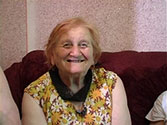
Yenta Kolodenker was born in Tulchyn in 1927. She is the wife of Lev Kolodenker. She has one brother and a sister. Her father was a baker. She survived the war in the Pechera ghetto. She lived in Israel briefly in the 1990s, but returned to Tulchyn. Her son lives in Canada. We interviewed her on January 8 and June 8, 2009 in Tulchyn.
Other Interviews:
Inside the Camp“all of Tulchyn into one courtyard”
Tulchyn, Ukraine
In December 1941, the Jews of Tulchyn, who had been languishing in the city’s ghetto for the first months of the war, were ordered to report for disinfection and relocation.
Romanian gendarmes gathered all the Jews together on one street and took them into a school, where they were counted and their valuables were confiscated. From the school, about 3000 Jews from Tulchyn were forcibly marched to the Pechera concentration camp.
In these clips, Yenta Kolodenko recalls the terrible conditions inside the school.

Aleksandr Kolodenker is the brother of Pesia and Lev Kolodenker. He was born in Tulchyn in 1929. During the war, he was imprisoned first in the Tulchyn ghetto and then in the Pechera concentration camp.
“they threw us out of our homes”
Tulchyn, Ukraine
Alexander Kolodenker remembers how he and his family were driven out of their homes in Tulchyn. On the way to the Pechera concentration camp, the Jewish community had to endure disinfection.

Penia Golfeld was born in Tulchyn in 1932. He was imprisoned in the Pechera concentration camp during the war. After the war, he trained at a technical institute and found work in a shoe factory, where he was employed for forty-nine years. He served for four years in the military. He married and has a son.
Other Interviews:
Inside the CampFrom Tulchyn to Pechera
Tulchyn, Ukraine
In December 1941, the Jews of Tulchyn, who had been languishing in the city’s ghetto for the first months of the war, were ordered to report for disinfection and relocation. A typhus epidemic was spreading through Transnistria—the region of Ukraine under Romanian occupation. Romanian authorities panicked at the typhus epidemic of late 1941, and, in some regions where the epidemic was already rampant, responded with extreme violence: in the last weeks of 1941 and first months of 1942, some 48,000 Jewish prisoners, mostly deportees from Bessarabia and Bukovina, were massacred in camps set up in Bogdanovka and Domanevka, in the Golta region of the southeastern part of Transnistria. The authorities justified the massacre as a means of preventing the spread of the disease and of protecting supply lines to the north. The massacre was also the culmination of a eugenics and purification mentality that had pervaded Romanian political and social thought.
The Jews of Tulchyn were gathered together and counted in a local school, where they were held for three days without food or water-- "packed together like sardines" in the words of one survivor. Afterwards, the 3,005 Jews of Tulchyn were taken to the city’s baths to be disinfected.
The Jews of Tulchyn were then forcibly marched through the town along the village road. They passed through the village of Torkiv, where they were housed in stables and the first victims perished. Those unable to walk were shot and left to die on the road.
The convoy eventually arrived in the town of Pechera, where, set on a cliff overlooking the Southern Bug River and surrounded by parkland was a three-story Romanesque palace that had once belonged to the Potocki noble family, but had been used as a sanatorium for tuberculosis patients by the Soviet government. It was an ideal isolation ward for quarantine purposes.
The Jews of Tulchyn and surrounding towns were dumped in the building and left to their own devices. This was not a labor camp nor technically a death camp—although death rates were exceedingly high. Rather, it was simply a de facto concentration camp, a place where the Romanians could quarantine Jews to prevent the typhus epidemic from spreading.
Over the course of the next months, additional shipments of Jews were brought into the camp, including about 750 Jews from Bratslav who were brought to the camp in January 1942, and several hundred more who arrived over the next few days from Ladyzhyn and Vapnyarka. Sporadic deportations into Pechera continued over the summer and fall: about 3,500 Jews from the Mohyliv-Podilskyy ghetto were deported to Pechera in two waves in July and October–November 1942. Many inmates of the camp were Bessarabian and Bukovinian Jews, whose long forced exodus from their homes in Romania finally ended here. In total about 9,000 Jews were held in Pechera.
In this clip, Pinia Golfeld talks about the ordeal endured by the Jews of Tulchyn and relates some of their experiences in the Pechera camp.
Source: Jeffrey Veidlinger, In the Shadow of the Shtetl: Small-Town Jewish Life in Soviet Ukraine (Indiana University Press, 2013)

Frida Pecherskaia was born in 1927 in Bratslav. Her father Yosif was a coachman. She had four siblings. Her brother Hershl died in the war at the age of 17, while serving in the Red Army. At the age of 12, Frida was imprisoned in the Pechera concentration camp, where she witnessed the murder of her mother. She also lost two of her sisters in the Pechera concentration camp. Frida escaped the camp and went to Bratslav but was taken back to Pechera by the Germans. After the liberation of the Pechera concentration camp, she returned to Bratslav. She has been living in Tulchyn since her wedding in 1945.
They Took Her – Alive
Tulchyn, Ukraine
Frida Pecherskaia, together with her mother and two sisters, was brought to Pechera from her native Bratslav. Her brother and father had both been drafted into the army before the Germans arrived in town. Her brother died at the front at the age of seventeen; her father survived. Her youngest sister, who was only six months old when they were taken to Pechera, died within a week of their arrival in the camp. Her other sister, Rivele, was also dying of hunger but had not yet succumbed when she was taken to be buried. The Jewish inmates charged with collecting the dead took her alive and threw her onto the cart of corpses.
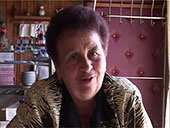
Rita Shveibish was born in 1936 in Tulchyn. She grew up with two brothers. Both of her parents were born in Tulchyn. Her father delivered products for a welding shop. She survived the war in Pechera. After the war, she trained in Vinnytsya as a nurse, and worked as a nurse for fifty years in Tulchyn. Since her retirement, she has been director of the Jewish community of Tulchyn and has been active in establishing memorials for the murdered Jews of the town.
Other Interviews:
Inside the CampBessarabian and Bukovinian Jews
Tulchyn, Ukraine
The Romanian authorities who seized control of Transnistria hoped to use it as a dumping ground for the Jews they were expelling from Bessarabia and Northern Bukovina—the provinces that Romania had acquired from Russia and Austria in the aftermath of the First World War, which were then seized by the Soviet Union in 1940 before being recaptured by Romania the following year. Romanian authorities sought to expel the Jews ostensibly in retaliation for the alleged Jewish support of the Soviet occupation. In reality, the Jews were victims of an extensive Romanian ethnic purification campaign. The little that has been written on Transnistria has focused on the fate of these approximately 150,000 Jewish deportees.
Between October 13 and November 15, 1941 another 46,000 Jews were deported across the river, this time mostly from Czernowitz in Northern Bukovina and several southern Bukovinian towns, including Suceava, Radauti, and Vatra Dornei. On November 7, 1941, about 9,000 Jews from Dorohoi were added to the deportees. For the initial deportees, Transnistria was only a transit point in their journey across the Southern Bug into German occupied territory, the Reichskommissariat Ukraine. But in November 1941 the Germans began to fear the spread of disease across the border and halted the deportations across the Southern Bug, resulting in the establishment of “colonies” of Romanian Jews between the two rivers. During the course of the war, about two-thirds of the Romanian deportees perished either during the forced marches across the Dniester, at the hands of German soldiers in Reichskommissariat Ukraine, or from starvation or disease in Transnistria.
The refugees, who tended to come from wealthier and more urban communities than those of Vinnytsya Province, brought with them valuables and money they had managed to salvage when they were forced out of their homes. The Bessarabian and Bukovinian Jews who sometimes arrived with valuables were initially better off and able to trade their jewels for food. This created resentment between the two communities, some of which persists to this day.
Source: Jeffrey Veidlinger, In the Shadow of the Shtetl: Small-Town Jewish Life in Soviet Ukraine (Indiana University Press, 2013)
Other Interviews:
BootsSobolivka Ancedote
Seeking Help From the Valedniker Rebbe
Openhanded
Avoiding Conscription
Childhood Memories
Studying Khimesh Dilemma
Hauling Stones
The Ribnitser Rebbe
The Shtefaneshter Rebbe
"they didn't want to let me go"
With the Last Train
When Peretz Markish Came to Polonne
The Jewish House
Sleeping At Grandpa's
A Few Pengos
Vynohradiv Ghetto
"Hitler ate up our youth"
Birobidzhan in 1941
the shoykhet across from us
Playing Fiddle with my Grandfather
"a memorial plaque"
Private Teacher
a Childhood Ditty
"Look, over there is a Jew"
a Poor Family
the Great Famine Exodus
a New Life
Throwing Stones on Kol Nidre
Around Kolomyya
People Stood Outside
Return to Kolomyya
Holidays
Fixing Shoes
March to Pechera
At the Yiddish School
The Goat
Yefingar Colony
Gefilte Fish
Celebrating Holidays
Toward Israel
Matzo Baking with Neighbors
Matzo Baking in the Shtetl
Passover Soup
Stuffed Neck with Chicken Fat
"a very religious family"
A Wealthy Family
Survival
"forward"
"go there"
Postwar Religious Practice
A Gravestone for My Mother
"make it a synagogue"
A Piece of Bread
Minkatch: a Jewish Town
The Hard Years
Tailored Suits
From Hungarian to Russian Forced Labor
Carving Tombstones
Communal Matzo Baking
Extinguishing Coals
Left Behind
A True "Khosid"
"Let her pray"
Selection at Auschwitz
A Child Lost To The Evil Eye
A Neolog Family
After The War
Yiddish and Hungarian
Bubbie Zisl
Coming Home
Vorkutlag
Childhood On A Farm
Mauthausen
"all of Tulchyn into one courtyard"
"they threw us out of our homes"
From Tulchyn to Pechera
They Took Her - Alive
Bessarabian and Bukovinian Jews
Show Trial in the Camp
Inside the Camp
Transport of Corpses
A Small Ladder to Heaven
Rebbe, Reb Shneyer
On the Way Home
Saving the Synagogue in Khust
Arrival in Prague
Liberation
Leaving For Home
Thank God We Had a Piece of Bread
Sobolivka
"...and we lived well"
"stuffing ourselves"
A Little House with a Dirt Floor
A Pair of Shoes
A Blanket to Fight Hunger
A Family Played the Fiddle
Avrum-Yosl the Glazier
Home: One Small Room
Running Away from the Melamed
The Great Synagogue
Cantor Gaz
Wooden Synagogue
Food on Sabbath
Sabbath Was Sabbath
"as though God had baked it"
Seder on a Kolkhoz
Hunger of 1946
"Der Shtern"
Peeking into the Men's Section
The Binding of Isaac
The Matzo Bag
"and a goat on a chain"
Eating Sour Mash - the Great Hunger
Kheskele - the Clarinetist
Burial Customs
"I was a courageous lad"
Krishmeleyenen
Hebrew - the Language of Prayer
"In short, I am a Jew"
Evacuation of the Communists
With Horse and Wagon to Donbas
Tashkent-Samarkand-Panjakent
Making Matzo Dough with a Roller
Craftsmen and Merchants
"I love Yiddish"
Valik, Zhuzhia and Ivanov
"And every day we waited to die"
Tsezeyt un tseshpreyt (Scattered and dispersed)
The Butcher's Synagogue
Army Training
Transmitting Secrets to America
At the Yiddish School
Postwar Charity
"the first bomb fell"
"as soon as they attacked, they were already here"
Tomashpil Massacre of August 4, 1941
Inside the Ghetto
Good Christians
The Jewish Soul
Bergider and Golda Meir
The Article
Antisemitism
Inside the Ghetto
The Orchard and the Mass Grave
The Southern Bug River
"Christ has risen"
Inside the Camp
"when I encountered the Germans"
Career in the Red Army
"Misha Katsop"
My Grandfather and the Priest
My Grandfather's Observance
"they wanted us to stay alive."
Speaking Yiddish
The Mass Grave in Sobolivka
"don't run into the forest"
Bratslav Matchmaking
"we need to have a wedding!"
“our children’s children’s children’s children must know”
A Great Hunger Myth
Jewish Professions
A Coachman's Song
Vanity of Vanities
I'm leaving you my dear in-laws
Getting Ready For Sabbath
How to Get Food
Liberation
Our House
What It Means to Be a Jew
Oy vey tsu mayne yorn (Woe to my years)
The Zogerin (the Synagogue Prompter)
Ekhod mi yoydeo (Who knows one)
Nuts
The Head of the Fish
Bones of Berdychiv
Dishes in the Attic
Aheym, briderlekh, aheym (Homeward, brother, homeward)
Physics in Yiddish
Oy mayn libe Basarabye (My Beloved Bessarabia)
Cholent
Bris
Sabbath and Poverty
Remedy for the Evil Eye
The Shiva
The Esebet (Reclining Bed)
Zits ikh mir in kretshme (I'm sitting in the Tavern)
The Fur Coat
Varenikes
Taking Out the Flour
Kosher Chicken
Oreme pleytim (Poor Refugees)
Money from America
May 27, 1942: Zhornyshche
The Tulchyn Pogrom
The Proskurov Pogrom
The Torgsin Store
From the Chimney to Berlin
From Tulchyn to Pechera
Let It Be Enough!
The Synagogue Cellar
The Reinsdorfs
The Prayer House
Evgeniia's Gefilte Fish
Arkadii's Gefilte Fish
Mama's Mamaliga
The Sabbath Candles
A Jew Must Eat Matzo
I Defended Stalingrad
Challah
Dovid's Gefilte Fish
Zionist Purim
Zhenya's Gefilte Fish
The Holiday Cycle
Revolutionary Celebrations and Jewish Holy Days
Khad Gadyo (One Little Goat)
Sonye's Gefilte Fish
Rolling an Egg
Homentashn
Writing in Soviet Yiddish
Remedy for the Whooping Cough
Maryam
Eating Tsimmes and Raising Geese
Women's Prayer Quorum
Sanctification of the Moon
“nobody gave”
Tulchyn, Ukraine

Donia Presler was born in 1929 born in Tulchyn. Her father was a musician. Her mother worked as a glazier. She had two sisters, one of whom died in the Pechera camp. She finished four years of Yiddish school. During the war, she was imprisoned in the Pechera camp for four years.
Other Interviews:
Passover SoupInside the Camp
A Little House with a Dirt Floor
A Family Played the Fiddle
Avrum-Yosl the Glazier
"Christ has risen"
The Torgsin Store
Homentashn
Show Trial in the Camp
Tulchyn, Ukraine

Penia Golfeld was born in Tulchyn in 1932. He was imprisoned in the Pechera concentration camp during the war. After the war, he trained at a technical institute and found work in a shoe factory, where he was employed for forty-nine years. He served for four years in the military. He married and has a son.
Other Interviews:
From Tulchyn to PecheraInside the Camp
Tulchyn, Ukraine
Penia Goldfeld describes in this clip the harsh circumstances, in which he survived the Pechera concentration camp . In particular, Penia recalls how he fought off starvation, eating beetroot during the winter period.
In total, about 15,000 Jews were deported from Transnistria into Reichskommissariat Ukraine between spring 1942 and early 1944, at least 4,800 of whom came from the Tulchyn district. In Bershad, the Gestapo, which had established a unit in the city in the spring of 1943, took about 1,200 residents into the Reichskommissariat for work, where most perished.
In the Reichskommissariat, the Germans worked the prisoners to death on starvation rations, or shot them when they became too sick to continue laboring. In a final statement, toward the end of the occupation as the Red Army approached, the retreating Germans murdered many of those Jews who had survived the labor brigades and remained relatively strong. About 2,500 prisoners from Pechera were seized for work in the Reichskommissariat.
This is how Pinia remembers German procedure to collect camp prisoners for forced labor:
Source: Jeffrey Veidlinger, In the Shadow of the Shtetl: Small-Town Jewish Life in Soviet Ukraine (Indiana University Press, 2013)

Pesia Kolodenker was born in Tulchyn in 1927. She is the sister of Lev and Aleksandr Kolodenker, as well as the husband of Nisen Kiselman. Her mother was a candy wrapper, before becoming a homemaker. She survived the war in the Tulchyn ghetto and Pechera concentration camp.
Other Interviews:
A Wealthy FamilyA Piece of Bread
At the Yiddish School
Bris
Transport of Corpses
Tulchyn, Ukraine
Throughout 1942-1943, the death rate in the Pechera concentration camp rose. Inmates were forced to work carting the dead out of the camp to a nearby mass grave in the forest, where the dead were buried. In this clip, Pesia Kolodenko remembers what the cart looked like as it rolled through the camp. Others we have interviewed recall sick relatives being taken alive to be buried.
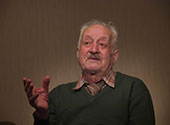
Boris Tzentziper was born in the village of Dobre, near Nikolaev, in 1923. He fought in the Red Army on the Eastern front in a battalion with 12 different nationalities.
A Small Ladder to Heaven
Mykolayiv, Ukraine
We interviewed Tzentziper in Mykolayiv in 2008 and he honored us with a kind of song that mourns the tragic fate of the Jewish people. Although he characterized the song as one of his own, it resembles another popular song that can be found in Beregovsky's collection of 1934. It appears that almost one stanza and part of the melody of Tzentziper's song were borrowed from there (text).
Un ikh vel aroyfkrikhn tsu got.
Eyne, tsvey verter, oy, vel ikh bay im fregn:
Farvos di yidn hobn in ergets nit keyn ort.
Un nokh vel ikh im zogn:
Az di yidn - hobn fargosn azoy fil blut.
Er zol baklern
un zol makhn az di yidn zoln lebn gut.
Un nokh vel ikh bay im betn:
Ot-di ale, vos zey hobn di yidn nit lib
zol er zey araynvarfn in grib.
I will climb to God
to ask him one or two things:
Why don't the Jews have a place anywhere.
And I will tell Him:
that the Jews shed so much blood.
He should consider this
and make sure that the Jews live well.
In addition, I will ask from Him:
Anyone who doesn't like the Jews
He should throw into a pit.
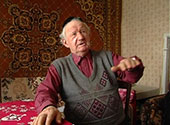
Semyon Vaisblai was born in 1930 in Chemerivtsi. His father worked as a cap-maker and his mother, who died when he was seven years old, was a homemaker. He had a sister and a brother. His brother died under occupation, and his sister served in the Red Army during the war. He attended a Yiddish school for four years. During the war, he was imprisoned in the Kamyanets-Podolskyy ghetto. He escaped the ghetto and, when he reached Chemerivtsi, he became the servant of a German soldier. He was then imprisoned in the Smotrich ghetto, before being sent back to the ghetto in Kamyanets-Podolskyy. The remaining time of the war, he spent on the kolkhoz in Dubinka. After the war, he worked various jobs, such as supplier and shop assistant. He worked as an administrator in the Khmelnytskyy’s synagogue in for many years.
Other Interviews:
Oy vey tsu mayne yorn (Woe to my years)Rebbe, Reb Shneyer
Khmelnytskyy, Ukraine
First part of the song "Rebbe, reb Shneyer" (also known as "Tsvey shayles," "Oy, rebenyu,"Tayerer rebenyu") continued to be popular in Ukraine and we heard it in various places (Iziaslav, Polonnoe, Vinnytsya). In this clip, Semyon Vaisblai sings a version that he remembers from Prokurov (now Khmelnytskyy), recorded in 2008.
Here is a full version of the Yiddish lyrics with an English translation. The song was commercially recorded by Rebecca Kaplan and Pete Rushefsky in 2009.
Oy, a tsore getrofn, mayn shkheynes shikse zeyer.
Oy, di shkheynishe shikse,
a make ir in ponim,
Iz gevorn mit mayn man di heymishe mekhutonim.
Oy, zog zhe, rebenyu, oy,
oy, zog zhe oy rebenyu, oy!
Oy, vaybele, vaybele - geyt aheym.
Un shikt tsu mir, zi areyn.
Un men nemt abisele ash.
Un me tutn arayn in a vash,
Ir zolt zikh gor nisht foyln,
Ir zolt zi legn oyf koyln.
Vet zi kosher vern.
Oh, a terrible thing has happened with my neighbor's gentile wife.
The gentile woman next door,
a plague on her face,
has become very familiar with my husband.
Dear Rabbi, oh, Rabbi Shneyer,
tell me!
Woman, woman - go home,
and send her in, to me.
Take some ashes.
Give her a good wash,
Don't be lazy.
heat her over coals.
She will be kosher.
Vaisblai also shared with us of Adolf King's well-known song "Sha Sha Der Rebbe Geyt (Shh, Shh, the Rabbi's Coming), which was written around 1922.
Other Interviews:
BootsSobolivka Ancedote
Seeking Help From the Valedniker Rebbe
Openhanded
Avoiding Conscription
Childhood Memories
Studying Khimesh Dilemma
Hauling Stones
The Ribnitser Rebbe
The Shtefaneshter Rebbe
"they didn't want to let me go"
With the Last Train
When Peretz Markish Came to Polonne
The Jewish House
Sleeping At Grandpa's
A Few Pengos
Vynohradiv Ghetto
"Hitler ate up our youth"
Birobidzhan in 1941
the shoykhet across from us
Playing Fiddle with my Grandfather
"a memorial plaque"
Private Teacher
a Childhood Ditty
"Look, over there is a Jew"
a Poor Family
the Great Famine Exodus
a New Life
Throwing Stones on Kol Nidre
Around Kolomyya
People Stood Outside
Return to Kolomyya
Holidays
Fixing Shoes
March to Pechera
At the Yiddish School
The Goat
Yefingar Colony
Gefilte Fish
Celebrating Holidays
Toward Israel
Matzo Baking with Neighbors
Matzo Baking in the Shtetl
Passover Soup
Stuffed Neck with Chicken Fat
"a very religious family"
A Wealthy Family
Survival
"forward"
"go there"
Postwar Religious Practice
A Gravestone for My Mother
"make it a synagogue"
A Piece of Bread
Minkatch: a Jewish Town
The Hard Years
Tailored Suits
From Hungarian to Russian Forced Labor
Carving Tombstones
Communal Matzo Baking
Extinguishing Coals
Left Behind
A True "Khosid"
"Let her pray"
Selection at Auschwitz
A Child Lost To The Evil Eye
A Neolog Family
After The War
Yiddish and Hungarian
Bubbie Zisl
Coming Home
Vorkutlag
Childhood On A Farm
Mauthausen
"all of Tulchyn into one courtyard"
"they threw us out of our homes"
From Tulchyn to Pechera
They Took Her - Alive
Bessarabian and Bukovinian Jews
Show Trial in the Camp
Inside the Camp
Transport of Corpses
A Small Ladder to Heaven
Rebbe, Reb Shneyer
On the Way Home
Saving the Synagogue in Khust
Arrival in Prague
Liberation
Leaving For Home
Thank God We Had a Piece of Bread
Sobolivka
"...and we lived well"
"stuffing ourselves"
A Little House with a Dirt Floor
A Pair of Shoes
A Blanket to Fight Hunger
A Family Played the Fiddle
Avrum-Yosl the Glazier
Home: One Small Room
Running Away from the Melamed
The Great Synagogue
Cantor Gaz
Wooden Synagogue
Food on Sabbath
Sabbath Was Sabbath
"as though God had baked it"
Seder on a Kolkhoz
Hunger of 1946
"Der Shtern"
Peeking into the Men's Section
The Binding of Isaac
The Matzo Bag
"and a goat on a chain"
Eating Sour Mash - the Great Hunger
Kheskele - the Clarinetist
Burial Customs
"I was a courageous lad"
Krishmeleyenen
Hebrew - the Language of Prayer
"In short, I am a Jew"
Evacuation of the Communists
With Horse and Wagon to Donbas
Tashkent-Samarkand-Panjakent
Making Matzo Dough with a Roller
Craftsmen and Merchants
"I love Yiddish"
Valik, Zhuzhia and Ivanov
"And every day we waited to die"
Tsezeyt un tseshpreyt (Scattered and dispersed)
The Butcher's Synagogue
Army Training
Transmitting Secrets to America
At the Yiddish School
Postwar Charity
"the first bomb fell"
"as soon as they attacked, they were already here"
Tomashpil Massacre of August 4, 1941
Inside the Ghetto
Good Christians
The Jewish Soul
Bergider and Golda Meir
The Article
Antisemitism
Inside the Ghetto
The Orchard and the Mass Grave
The Southern Bug River
"Christ has risen"
Inside the Camp
"when I encountered the Germans"
Career in the Red Army
"Misha Katsop"
My Grandfather and the Priest
My Grandfather's Observance
"they wanted us to stay alive."
Speaking Yiddish
The Mass Grave in Sobolivka
"don't run into the forest"
Bratslav Matchmaking
"we need to have a wedding!"
“our children’s children’s children’s children must know”
A Great Hunger Myth
Jewish Professions
A Coachman's Song
Vanity of Vanities
I'm leaving you my dear in-laws
Getting Ready For Sabbath
How to Get Food
Liberation
Our House
What It Means to Be a Jew
Oy vey tsu mayne yorn (Woe to my years)
The Zogerin (the Synagogue Prompter)
Ekhod mi yoydeo (Who knows one)
Nuts
The Head of the Fish
Bones of Berdychiv
Dishes in the Attic
Aheym, briderlekh, aheym (Homeward, brother, homeward)
Physics in Yiddish
Oy mayn libe Basarabye (My Beloved Bessarabia)
Cholent
Bris
Sabbath and Poverty
Remedy for the Evil Eye
The Shiva
The Esebet (Reclining Bed)
Zits ikh mir in kretshme (I'm sitting in the Tavern)
The Fur Coat
Varenikes
Taking Out the Flour
Kosher Chicken
Oreme pleytim (Poor Refugees)
Money from America
May 27, 1942: Zhornyshche
The Tulchyn Pogrom
The Proskurov Pogrom
The Torgsin Store
From the Chimney to Berlin
From Tulchyn to Pechera
Let It Be Enough!
The Synagogue Cellar
The Reinsdorfs
The Prayer House
Evgeniia's Gefilte Fish
Arkadii's Gefilte Fish
Mama's Mamaliga
The Sabbath Candles
A Jew Must Eat Matzo
I Defended Stalingrad
Challah
Dovid's Gefilte Fish
Zionist Purim
Zhenya's Gefilte Fish
The Holiday Cycle
Revolutionary Celebrations and Jewish Holy Days
Khad Gadyo (One Little Goat)
Sonye's Gefilte Fish
Rolling an Egg
Homentashn
Writing in Soviet Yiddish
Remedy for the Whooping Cough
Maryam
Eating Tsimmes and Raising Geese
Women's Prayer Quorum
Sanctification of the Moon
Oy iz dus a Rebenyu” (Oh is that a Rabbi)
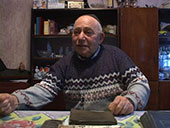
Moisei Katz grew up with six siblings. His father was a coachman for wood transportation. He attended heder until the age of thirteen. After his father was "drafted" as forced laborer in the Hungarian army, he continued his father's work as coachman. In 1944, he was deported to Auschwitz-Birkenau from the Iza ghetto. He was liberated from the Buchenwald concentration camp by the American army in 1945 and returned to Koshelovo, via Prague and Budapest. He moved to Khust in 1954 and worked in his profession as chauffeur.
Other Interviews:
Saving the Synagogue in KhustArrival in Prague
Liberation
Leaving For Home
On the Way Home
Khust, Ukraine
In this clip, Katz speaks about his experiences on his homeward journey, when he and his cousins met a fellow-Jew from his hometown Koshelovo.
After the liberation of Nazi camps by the American, British or Soviet armed forces in Spring 1945 a large number of Jewish survivors attempted to make their way back to their hometowns in Eastern Europe. Just like Moisei Katz, who was among the thousands of Carpatho-Ruthenian Jews who returned to southwestern Ukraine. The region of Transcarpathia was officially annexed to the Soviet Union in June 1945.
Those lucky enough to find a close or distant relative restarted their lives in postwar Transcarpathia with them and often decided together how to deal with the new Soviet reality. Jewish returnees, who were not lucky enough to encounter a family member or relative in their hometowns, looked for Jewish or non-Jewish friends in order not to have to face reality alone and to arrange for a familiar setting. Katz remembers the historical moment in this clip.
View map to follow the trajectories of Carpatho-Rusiyan Jews back to Transcarpathia.

Moisei Katz grew up with six siblings. His father was a coachman for wood transportation. He attended heder until the age of thirteen. After his father was "drafted" as forced laborer in the Hungarian army, he continued his father's work as coachman. In 1944, he was deported to Auschwitz-Birkenau from the Iza ghetto. He was liberated from the Buchenwald concentration camp by the American army in 1945 and returned to Koshelovo, via Prague and Budapest. He moved to Khust in 1954 and worked in his profession as chauffeur.
Other Interviews:
On the Way HomeArrival in Prague
Liberation
Leaving For Home
Saving the Synagogue in Khust
Khust, Ukraine
How did Jewish returnees re-settle in places that were once part of a cohesive and vibrant prewar Jewish community? The daily disappointment of finding out who did not survive and thus not return home is no doubt a reality of every Jewish returnee. However, diving into testimonies of Carpathian Ruthenian Jews, another reality seems to emerge: the necessity to move on and continue life, even under the new Soviet rule. The sense of community, reinforced by the shared fate as Shoah survivors, and reconstituting traditional Jewish life appears to be evident among Carpathian-Ruthenian Jews in Subcarpathian Rus' during the postwar period. In this clip, Moisei Katz shares with us an episode about the rescue of a synagogue in Khust in the early 1950s.

Moisei Katz grew up with six siblings. His father was a coachman for wood transportation. He attended heder until the age of thirteen. After his father was "drafted" as forced laborer in the Hungarian army, he continued his father's work as coachman. In 1944, he was deported to Auschwitz-Birkenau from the Iza ghetto. He was liberated from the Buchenwald concentration camp by the American army in 1945 and returned to Koshelovo, via Prague and Budapest. He moved to Khust in 1954 and worked in his profession as chauffeur.
Other Interviews:
On the Way HomeSaving the Synagogue in Khust
Liberation
Leaving For Home
Arrival in Prague
Khust, Ukraine
After the liberation from Nazi concentration camps and ghettos in 1945, many Jewish survivors decided to go back to towns and villages they grew up in. The need and longing to go home endured the dire circumstances and length of such a return journey, not to mention the weak physical conditions the survivors were in.
In the immediate postwar months of 1945: More than 10,000,000 displaced persons voyaged home with as many as 10,500 people a day. A large fraction of displaced persons traveled to Eastern Europe.
As a result, returnees had to endure the chaotic conditions of traveling on the roofs of packed wagons, in trains without a schedule. Another memory is also present: Red Army soldiers at stations, in trains, and at borders. Jewish returnees went through different, what can be called stations on their way home, passing through cities like Prague, Bratislava, Budapest and sometimes Bucharest, on a long term quest to find loved ones.
Although oftentimes Jewish returnees would find a close family member, relative, friend or acquaintance in one of these stations, the urge to return home to find out what happened to the place where they came from outlived in many cases the initial comfort they felt being taken care of among their own in resurgent Eastern Jewish communities.
This clip shows a snippet of Katz's experience on his journey home.

Moisei Katz grew up with six siblings. His father was a coachman for wood transportation. He attended heder until the age of thirteen. After his father was "drafted" as forced laborer in the Hungarian army, he continued his father's work as coachman. In 1944, he was deported to Auschwitz-Birkenau from the Iza ghetto. He was liberated from the Buchenwald concentration camp by the American army in 1945 and returned to Koshelovo, via Prague and Budapest. He moved to Khust in 1954 and worked in his profession as chauffeur.
Other Interviews:
On the Way HomeSaving the Synagogue in Khust
Arrival in Prague
Leaving For Home
Liberation
Khust, Ukraine
Displaced persons were scattered in different former Nazi forced labor and concentration camps throughout Austria and Germany at liberation. They experienced several camp liquidations and subsequent death marches from one concentration camp to the next. The experience of the following step, after the liberation, was defined by the proceedings of either American, British or Soviet armed forces. Overall, a significant amount of Jewish survivors felt the urge to return to what they knew as home, before making any other life-changing decisions regarding moving and/or emigration.
One of the more noticeable differences between American and Soviet liberators for example, found in the survivors’ narratives, has to do with the degree to which they took care of the former inmates. One can sense an overwhelming positive experience of “American care-taking,” where former prisoners were immediately taken to hospitals or doctor check-ups, nourished back to health with a gradual increase of food intake. Furthermore, the tragic experience of “overeating,” because people’s stomachs, that had been used to starved rations for so long, and could not take the distributed rich food, was a deep-seated memory of this period. Survivors’ memories of the “Russian care-taking” ranges from being nourished back to health in some form or other to receiving no attention at all. The former inmates’ recovery process would often take up to several months until they were in an acceptable condition to face the incredibly arduous journey home.
Another memory concerns the acquisition of food and clothing. According to several accounts, survivors were given permission by the Red Army, and to an extend American army, to (forcefully) take whatever they needed from German homes or former inmates also proceeded without any permission at all. In this clip, Katz talks about his liberation from the Buchenwald concentration camp in Weimar, Germany, by the American armed forces in April 1945.

Moisei Katz grew up with six siblings. His father was a coachman for wood transportation. He attended heder until the age of thirteen. After his father was "drafted" as forced laborer in the Hungarian army, he continued his father's work as coachman. In 1944, he was deported to Auschwitz-Birkenau from the Iza ghetto. He was liberated from the Buchenwald concentration camp by the American army in 1945 and returned to Koshelovo, via Prague and Budapest. He moved to Khust in 1954 and worked in his profession as chauffeur.
Other Interviews:
On the Way HomeSaving the Synagogue in Khust
Arrival in Prague
Liberation
Leaving For Home
Khust, Ukraine
After the liberation from Nazi concentration camps in spring 1945, many Jewish survivors felt the need to return home, before contemplating their next step in life. In the hope to find family members or at the least to recover family possessions, survivors often came to this decision facing much more promising options emigration. This was also the case with Katz, who decided to return to his hometown Koshelovo in southwestern Ukraine (Transcarpathia).
Carpathian-Rusiyan Jews initially thought that they returned home as Czechoslovak citizens. This impression was well justified since for instance Czechoslovak troops came into the liberated camps and “collected” their people or the American occupational administration arranged the former inmate population according to citizenship to facilitate the dissolution of the camp. Each individual’s journey home was a different experience, especially regarding duration, and often dependent on the arrangements – if any - made by the American or Soviet armed forces. The need and longing to go home endured the dire circumstances and length of such a return journey.
In the immediate postwar months of 1945: More than 10,000,000 displaced persons voyaged home with as many as 10,500 people a day. A large fraction of displaced persons traveled to Eastern Europe.
As a result, returnees had to endure the chaotic conditions of traveling on the roofs of packed wagons, in trains without a schedule. Another memory is also present: Red Army soldiers at stations, in trains, and at borders. Jewish returnees went through different, what can be called stations on their way home, passing through cities like Prague, Bratislava, Budapest and sometimes Bucharest, on a long term quest to find loved ones.
Katz talks about his experience, when passing through Bratislava and Budapest with his cousins and uncle.
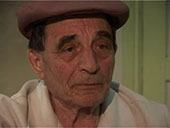
Isaak Vaisman 's father, who died in 1928, was also born in Berdychiv and had worked as a tailor. He grew up with one sister. He attended a Yiddish school for seven years, before he was transferred to a Russian school to complete his education. He evacuated to Uzbekistan when the war began, from where he was drafted into the Red Army. He served from 1943 until 1946 in an intelligence unit. After his retirement, he worked as soda seller on the market.
Thank God We Had a Piece of Bread
Berdychiv, Ukraine
Isaak Vaisman’s pride in serving his country during the war was evident, but when asked when he had experienced the best times of his life, he answered without hesitation, “My youth.” After hearing him describe his childhood, one could only imagine how much worse things must have become for these to have been his best years.
Isaak and his wife Bella say that her family did provide some charity for the poorer families, like the Vaismans, who lived in the same building block. Those who grew up poor often relied upon the beneficence of those who were a little more fortunate. At least until the government began arresting the wealthier members of the community, there was often a philanthropist in town who helped alleviate the struggles of the destitute.
Isaak Vaisman was seventy-seven years old and still doing backbreaking work selling seltzer water in the Berdychiv marketplace.He pries open a heavy rusting canister with a wrench and pours seltzer into glasses for the waiting customers who tossed him a couple of kopecks for a swig. He worked silently, rarely exchanging pleasantries with his thirsty customers, and only turning his attention from the queue to glance at the canister’s gauge and adjust the pressure of the gas.
Source: Jeffrey Veidlinger, In the Shadow of the Shtetl: Small-Town Jewish Life in Soviet Ukraine (Indiana University Press, 2013)

Arkadii Burshtein was born in Sobolivka in 1928. His father was a tailor. He attended a Yiddish school for four years, and then finished his education in a Ukrainian school. He survived in labor camps in the Reichkommissariat Ukraine before making his way into Transnistria. After the war he returned to Haysyn, where he worked as chief engineer in a garment factory.
Other Interviews:
Sobolivka AncedoteMy Grandfather and the Priest
My Grandfather's Observance
"they wanted us to stay alive."
Speaking Yiddish
The Mass Grave in Sobolivka
Arkadii's Gefilte Fish
Sobolivka
Haysyn, Ukraine
Settlement and occupational patterns in pre-war Ukraine were sharply demarcated by ethnicity. Jews tended to live in shtetlekh, where their residences were concentrated around the main square, and where they worked as artisans and merchants. In this clip, Arkadii Burshtein remembers that the Christians lived around the shtetl, and the Jews lived within it. This impression of two starkly demographically distinct regions is supported by census data. According to the 1926 census, whereas only 11 percent of all Ukrainians--Jews and non-Jews--lived in urban centers, 91.4 percent of Ukrainian Jews were urban. Even the most heavily Jewish cities were still surrounded by non-Jewish countryside. Jews were also distinguished by occupation, and many people we spoke with drew sharp distinctions between the Christian peasants who lived in the countryside and the Jewish artisans who lived in the city. Again, the census figures confirm that Jews dominated certain handicrafts, such as tailors, cobblers, glaziers, coopers, and coachmen.

Bella Vaisman was born in 1925 in Berdychiv. Her father was born in Warsaw and worked as a chief accountant. She grew up in a relatively wealthy family. Days before the war began, she went to visit her cousin, as a result of which she was cut of from the rest of her family. She survived the war in evacuation in Uzbekistan, but her family was killed in Berdychiv. She was married to Isaak Vaisman.
Other Interviews:
"a very religious family"Sabbath Was Sabbath
The Reinsdorfs
“…and we lived well”
Berdychiv, Ukraine
When Bella Vaisman, nee Rainsdorf, was a child she lived in the same building block as Isaak Vaisman who would become her husband after the war. Bella came from a wealthier family, while her husband experienced a childhood in poverty. Her father, born in Warsaw, had come to Berdychiv as a refugee during the First World War, but was able to make a living for himself in the Soviet Union as a bookkeeper.

Efim Skobilitskii was born in 1919 in Berdichev. His father was born in Poland, near Warsaw, and worked as a metalworker. His mother raised five sons. He studied in both a Yiddish school and in a cheder. During World War II, he served in the Red Army as the commander of a battalion of tanks. After he was demobilized in 1949, he returned to Berdychiv and was trained as an agronomist. He worked at a warehouse transfer station for kolkhozi and zovkhozi for thirty-five years.
Other Interviews:
"when I encountered the Germans"Career in the Red Army
The Zogerin (the Synagogue Prompter)
“stuffing ourselves”
Berdychiv, Ukraine
Efim Skoblitsky recollects great poverty during his childhood. Although his family lived comparatively well-off, the memory of beggars and peddlers are engraved on his mind.
Efim, however, also remembers a philanthropist named Magazanik, who exported leather from the leather factory, where Vaisman’s mother worked, to Czechoslovakia. According to Efim, "Magazanik was a great landowner. He would lead his cattle along the entire street and would carry dairy products, like butter and sour cream, to sell in Zhytomyr and Kiev. And over there, he planted an orchard with all kinds of trees. Now it’s a street where they have added new buildings. It used to be a long orchard along the street.” Magazanik, Skoblitsky went on, lost most of his wealth when it was expropriated by the Soviet state and his property was seized for communal use.
It is perhaps in tribute to Magazanik that the Berdychiv-born writer Vassili Grossman gave the name of Efim Magazanik to the poor Jewish blacksmith who is forced to host a pregnant Red Army soldier during the Civil War in his 1934 short story, “In the Town of Berdychiv” a story later made famous by Aleksandr Askoldov’s 1967 film Commissar. Grossman was, perhaps, making an ironic comment on the fate of the wealthy under Bolshevism, by taking the name of this locally famous aristocrat and philanthropist for his poor blacksmith.
Source: Jeffrey Veidlinger, In the Shadow of the Shtetl: Small-Town Jewish Life in Soviet Ukraine (Indiana University Press, 2013)

Donia Presler was born in 1929 born in Tulchyn. Her father was a musician. Her mother worked as a glazier. She had two sisters, one of whom died in the Pechera camp. She finished four years of Yiddish school. During the war, she was imprisoned in the Pechera camp for four years.
Other Interviews:
Passover SoupShow Trial in the Camp
Inside the Camp
A Family Played the Fiddle
Avrum-Yosl the Glazier
"Christ has risen"
The Torgsin Store
Homentashn
A Little House with a Dirt Floor
Tulchyn, Ukraine
Donia Presler remembers the communal aspect of shtetl life very well. A popular picture often found in literature as part of a romantic perception of the Shtetl. Donia reminisces cheerfully about eating, dancing and singing together. But even Donia's account does not escape reality and describes the existence of sheer poverty in the shtetl.
During the Civil War, the fledgling Soviet State sought to orient all its resources toward fueling the Red Army’s efforts by instituting an economic policy known as “War Communism.” In the infancy of the Revolution,the engineers of Soviet ideological and economic policy believed they were implementing pure communism and foresaw world revolution close behind. The state nationalized the banks and large industry,centralized industrial management, introduced a state monopoly on trade, and criminalized private enterprise and exchange.
These policies disenfranchised anybody who employed hired labor, received income from sources other than employment, or worked as private merchants,brokers, or religious functionaries. Jews predominated in each of these categories. Living mainly in the urban centers, where commerce and industry were most concentrated, Jews were subject to the worst of the military requisitions and property seizures.
Relying overwhelmingly on private enterprise and trade for their livelihood — the two occupations most targeted for elimination by the new government — the Jewish middling class was one of the major victims of the Revolution. Jews, who accounted for just 5.4 percent of the total population of Ukraine, constituted 45 percent of disenfranchised people, based on figures from 1925–1926.
Many Jews thereby lost the emancipation rights that the Provisional Government had only just recently awarded them. Previously persecuted for their religious beliefs, they now faced persecution instead for their sociological and economic status.
Source: Jeffrey Veidlinger, In the Shadow of the Shtetl: Small-Town Jewish Life in Soviet Ukraine (Indiana University Press, 2013)

Evgeniia Kozak was born in 1926 in Bershad. She attended a Ukrainian school for eight years. Her parents, who were cousins, were both born in Bershad. Her father was a furrier. She had a younger brother and sister. She survived the war in evacuation in Bezopasnik, Orlovsky Region in the Caucasus and then in Andizhanskaia in the Stalinska region in Central Asia. When she returned to Bershad after the war, in April 1944, her mother worked as a baker. She married in 1958 and has two sons. Her husband died before her second son was born, when her first son was just one and a half years old.
Other Interviews:
Stuffed Neck with Chicken FatFood on Sabbath
Postwar Charity
Evgeniia's Gefilte Fish
A Pair of Shoes
Bershad, Ukraine
The Jews of the Podolian shtetls remember the 1920s and 1930s as a time of great need and want, but they also recognize that within this period there was a sense of community and mutual aid. Many recall their fellow Jews sharing food and helping out. At least in the early 1920s, they claim, the community was close-knit and neighbors helped one another.
Many Yiddish songs that shtetl Jews sang in this period bemoaned the poverty of the shtetl. The same melancholy phrases and idioms of poverty recur in numerous songs. Young orphan children are always wandering through the dark and cold streets of the shtetl barefoot, dreaming only of a pair of shoes, for which they would pawn their last shirt. Evgeniia Kozak, who grew up in Bershad in the 1920s, sung several songs for us incorporating these themes. One, in particular, weaved them all together in a lament of poverty, want, and destitution:
Ikh hob shoyn nit keyn shikhelekh.
Aroystsugeyn in gas.
Ven mayn oreme muter volt atsind gelebt
Zi volt farzetst dos letste hemd.
Arayn in tifn noyt.
Un volt far ir yoseml a por shikhelekh gekoyft.
Der lerer fun der shul zogt ikh bin a kind, a brilyant
Un ale raykhe yingelekh lakhn fun mayn shand.
Azoy iz avekgon tsvelef yor derkhanand
Un fun dem oremen yosem iz gevorn...
Di oreme muter hot farzetst dos letste hemd
Un hot far dem yoseml a por shikhelekh gekoyft.
Azoy iz avekgon tsvelef yor derkhanand
Er zitst in tsimer un drikt im di hant.
Tsi gedenkstu shoyn tatenyu tsurik mit tsvelef yor
Ven du host mir gekoyft shikhelekh a por?
Un derfar vos du host mir gekoyft shikhelekh a por
Vel ikh dikh gliklekh makhn ale dayne yor.
And I have no shoes,
To go out on the street.
If my poor mother were still alive,
She would pawn her last shirt.
Never mind her extreme need,
And would buy a pair of shoes for her little orphan.
My school teacher says I am a precious child,
And all the rich children laugh at my shame.
So twelve years passed,
And since then this poor orphan has become...
My poor mother has pawned her last shirt,
And bought her orphan a pair of shoes.
So, twelve years have passed,
He sits in his room and wrings his hands,
Do you still remember your son after twelve years?
When you bought me a pair of shoes?
And because you bought me that pair of shoes,
I will make you happy for all your years.
Source: Jeffrey Veidlinger, In the Shadow of the Shtetl: Small-Town Jewish Life in Soviet Ukraine (Indiana University Press, 2013)
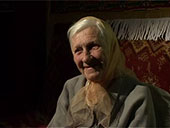
Raisa Chukh Her father, who was born in Poland, made and sold colanders, and her mother was the manager of an artel. She trained as a nurse before the war, but was not sent to the front because she had a toddler to care for, and instead evacuated to the Caucasus, where she worked as a surgeon’s assistant. After the war, she continued working as a nurse until the age of seventy-three. She was head nurse at her hospital for forty years.
A Blanket to Fight Hunger
Berdychiv, Ukraine
Raisa Chukh remembers how much she and her two little brothers suffered during the Great Famine (Holodomor ) of 1932-33. According to Raisa, her mother saved the family from starvation through innovative creativity as a blanket seamstress.
In 1931, the Soviet central government’s insistence on meeting outrageous procurement quotas and their obstinate refusal to yield to local needs, combined with climactic conditions, created a massive famine in 1932–1933 that left some 2.5 to 3.5 million people dead. Today, many historians believe the famine was manufactured as a deliberate policy to punish the people of Ukraine for their resistance to collectivization.
Source: Jeffrey Veidlinger, In the Shadow of the Shtetl: Small-Town Jewish Life in Soviet Ukraine (Indiana University Press, 2013)

Donia Presler was born in 1929 born in Tulchyn. Her father was a musician. Her mother worked as a glazier. She had two sisters, one of whom died in the Pechera camp. She finished four years of Yiddish school. During the war, she was imprisoned in the Pechera camp for four years.
Other Interviews:
Passover SoupShow Trial in the Camp
Inside the Camp
A Little House with a Dirt Floor
Avrum-Yosl the Glazier
"Christ has risen"
The Torgsin Store
Homentashn
A Family Played the Fiddle
Tulchyn, Ukraine
Occupational prestige was part of a complex and ambiguous social hierarchy in the Soviet shtetl. Whereas many aspired toward higher education and professional lives, the practical value of possessing a set of artisanal skills was obvious. This occupational opacity was most evident in occupations that possessed both professional and trade characteristics. Donia Presler’s father was a professional musician. Like many other trades, musicians learned their skills in the family, as she clarifies in this clip.
Donia explains that her father lived in Odessa in the 1920s, where he even played with famed Jewish Jazz musician Leonid Utesov. When her father moved to Tulchyn, he also played in a band. In this clip, Donia reminisces about shtetl klezmorim (musicians):
Source: Jeffrey Veidlinger, In the Shadow of the Shtetl: Small-Town Jewish Life in Soviet Ukraine (Indiana University Press, 2013)

Donia Presler was born in 1929 born in Tulchyn. Her father was a musician. Her mother worked as a glazier. She had two sisters, one of whom died in the Pechera camp. She finished four years of Yiddish school. During the war, she was imprisoned in the Pechera camp for four years.
Other Interviews:
Passover SoupShow Trial in the Camp
Inside the Camp
A Little House with a Dirt Floor
A Family Played the Fiddle
"Christ has risen"
The Torgsin Store
Homentashn
Avrum-Yosl the Glazier
Tulchyn, Ukraine
Occupations tended to run in the family. Not only did Donia Presler's father's side of the family pass on musical skills from one generation to the next, but her mother's side also passed on their glazier expertise.
Since gigs as a klezmer musician were hard to come by, Presler’s father had to supplement his income with artisanal work. In this clip, Donia describes how her parents carried on the glazier tradition Donia's mother inherited from her grandfather Avrum-Yosl. Donia's parents made a living by selling windowpanes in Ukrainian villages surrounding the town of Tulchyn.
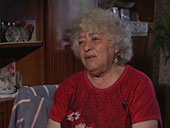
Asya Barshteyn 's father was a purveyor and her mother was a homemaker. She attended a Yiddish school for six years, until her schooling was interrupted by the war. She survived the war in the Sharhorod ghetto. After the war, she completed her schooling by correspondence. She worked as a telegraph dispatcher and a switchboard operator at the post office, and later as a cashier at a barber shop. In 1983 she moved to Vinnytsya,where she is one of the leaders of the Vinnytsya Jewish Women’s Choir.
Other Interviews:
Rebbe, Reb ShneyerThe Great Synagogue
Cantor Gaz
"as though God had baked it"
Home: One Small Room
Vinnytsya, Ukraine
Asya Barshteyn remembers how her father struggled to raise his three daughters well and marry them off adequately. In this clip, she recalls the tiny house they lived in, typical of the time and place.
In part because of their work duties, Jewish women tended to marry later than their non-Jewish neighbors. According to the 1926 census, Jewish men were getting married in their mid-twenties and Jewish women in their early twenties. In Right Bank Ukraine, most Jewish men were married by the age of twenty-five and women by age twenty-two.
Yet, for many women, marriage was not so easy. As a result of the violence that plagued the region - 76 percent of the victims of the pogroms were men —there were 1,140 Jewish women for every 1,000 Jewish men in 1926, and 1,160 Jewish women for every 1,000 Jewish men in 1939.
The marriage market was a competitive one, and many women never married.
Source: Jeffrey Veidlinger, In the Shadow of the Shtetl: Small-Town Jewish Life in Soviet Ukraine (Indiana University Press, 2013)
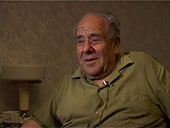
Arkadii Furer was born in Kryzhopil in 1920. Both his parents were also natives of the town. His father was a tailor. He had two brothers, one of whom was killed fighting during the Second World War. He studied in a Yiddish school for four years, before finishing his education in a Russian school. In 1940, Furer was drafted into the army, and was in Chişinău when the war broke out. He fought first in the Caucasus, and then in Stalingrad where he was injured, but continued fighting, becoming the commander of his division and serving in Crimea. Toward the end of the war, he moved with the army through Belarus, Latvia, and Lithuania, reaching Kaliningrad. He returned to Kryzhopil in 1947 and became the manager of a shop. At the age of sixty, he moved to Vinnytsya to work for the railroad company.
Running Away from the Melamed
Vinnytsya, Ukraine
Avrom Furer bitterly remembers how the children at the state Yiddish school he attended would mock him mercilessly for receiving private religious instruction from a religious teacher (melamed). The students viewed it as anomalous and were thus affected by the antireligious morals and values Soviet society enforced.
Religious schools (cheder) were part of the traditional system of Jewish education in which sacred texts were given exclusive attention in the curriculum and had long been the bedrock of Jewish education in Eastern Europe.
Source: Jeffrey Veidlinger, In the Shadow of the Shtetl: Small-Town Jewish Life in Soviet Ukraine (Indiana University Press, 2013)

Asya Barshteyn 's father was a purveyor and her mother was a homemaker. She attended a Yiddish school for six years, until her schooling was interrupted by the war. She survived the war in the Sharhorod ghetto. After the war, she completed her schooling by correspondence. She worked as a telegraph dispatcher and a switchboard operator at the post office, and later as a cashier at a barber shop. In 1983 she moved to Vinnytsya,where she is one of the leaders of the Vinnytsya Jewish Women’s Choir.
Other Interviews:
Home: One Small RoomRebbe, Reb Shneyer
Cantor Gaz
"as though God had baked it"
The Great Synagogue
Vinnytsya, Ukraine
Asya Barshteyn reminisces about Sharhorod's Great Synagogue. She describes the synagogue's activity during the war, the transformation of the building into a juice factory during the postwar Soviet era and today's absence of congregants to attend prayer services.
She then discusses how each occupation had its own synagogue, and reminisces about the guest cantors who would occasionally visit the shtetl from neighboring cities.

Asya Barshteyn 's father was a purveyor and her mother was a homemaker. She attended a Yiddish school for six years, until her schooling was interrupted by the war. She survived the war in the Sharhorod ghetto. After the war, she completed her schooling by correspondence. She worked as a telegraph dispatcher and a switchboard operator at the post office, and later as a cashier at a barber shop. In 1983 she moved to Vinnytsya,where she is one of the leaders of the Vinnytsya Jewish Women’s Choir.
Other Interviews:
Home: One Small RoomRebbe, Reb Shneyer
The Great Synagogue
"as though God had baked it"
Cantor Gaz
Vinnytsya, Ukraine
Asya Barshteyn remembers the synagogue as the center of Jewish communal and cultural life in the shtetl. She recalls the excitement of hearing visiting cantors who would occasionally tour and perform there. For Barshteyn, with a continued love of music and song, the cantor was the highpoint of religious life. The synagogue building, however, represents much more than a religious identity, and serves as the focal point of the community.
Source: Jeffrey Veidlinger, In the Shadow of the Shtetl: Small-Town Jewish Life in Soviet Ukraine (Indiana University Press, 2013)

Grigorii Shor was born in Kopayhorod in 1925. His father was a butcher. He studied for seven years at a Yiddish school and finished his education in a Ukrainian school. He lived in Kopayhorod until he was drafted into the military in 1944. Her remained in the military until 1971.
Other Interviews:
Matzo Baking in the ShtetlWooden Synagogue
Vinnytsya, Ukraine
Grigorii Shor has distinct memories of attending the wooden two-storied synagogue in Kopayhorod with his father until it was closed in 1936.
It is fascinating from an ethnographic standpoint to watch Grigorii in the process of remembering details of life in the shtetl of the 1930s in Yiddish - a language he had not spoken for 60 years. At times he struggles to find the appropriate terminology, having spent most of his adult life in the secular Soviet state speaking Russian. His wife, Liudmila, interjects repeatedly, trying to help him out, as does Dov-Ber Kerler, who is conducting the interview.

Evgeniia Kozak was born in 1926 in Bershad. She attended a Ukrainian school for eight years. Her parents, who were cousins, were both born in Bershad. Her father was a furrier. She had a younger brother and sister. She survived the war in evacuation in Bezopasnik, Orlovsky Region in the Caucasus and then in Andizhanskaia in the Stalinska region in Central Asia. When she returned to Bershad after the war, in April 1944, her mother worked as a baker. She married in 1958 and has two sons. Her husband died before her second son was born, when her first son was just one and a half years old.
Other Interviews:
Stuffed Neck with Chicken FatA Pair of Shoes
Postwar Charity
Evgeniia's Gefilte Fish
Food on Sabbath
Bershad, Ukraine
In postwar Soviet Ukraine foodways provided one of the few means of expressing ethnic identity and memory. After so much of the old world was destroyed, food provided a means of memorializing and commemorating a past that could not be publicly expressed. In this clip Evgeniia Kozak gets lost in her memories of cholent.
Food was also strongly associated with religious festivals and practice, a phenomenon by no means unique to Soviet Jewry. Sabbath foods— challah, gefilte fish, cholent, and latkes — feature prominently in memories of the Sabbath.
Cholent, in particular, a slow-cooked stew, usually consisting of meat, barley, beans, potato, and whatever else could be found around the house, symbolizes the Sabbath for many. The Sabbath rest prohibits cooking from Friday evening through Saturday sunset, but does allow the consumption of a hot meal provided that the fire was lit before the onset of the Sabbath. It is traditional, therefore, to place the stew in the oven prior to the start of the Sabbath, on Friday evening, and remove it, fully cooked, for lunch on Saturday.
Source: Jeffrey Veidlinger, In the Shadow of the Shtetl: Small-Town Jewish Life in Soviet Ukraine (Indiana University Press, 2013)

Bella Vaisman was born in 1925 in Berdychiv. Her father was born in Warsaw and worked as a chief accountant. She grew up in a relatively wealthy family. Days before the war began, she went to visit her cousin, as a result of which she was cut of from the rest of her family. She survived the war in evacuation in Uzbekistan, but her family was killed in Berdychiv. She was married to Isaak Vaisman.
Other Interviews:
"a very religious family""...and we lived well"
The Reinsdorfs
Sabbath Was Sabbath
Berdychiv, Ukraine
In Bella Vaisman’s recollection, the memory of food evokes visceral emotions that beautify the moment: “Since it was Sabbath everything was good.”Sabbath time was sacred, rendering even the profane good. For those who formally welcomed the Sabbath with prayer on Friday evenings, lighting Sabbath candles and eating traditional challah bread was an important part of the custom.
Source: Jeffrey Veidlinger, In the Shadow of the Shtetl: Small-Town Jewish Life in Soviet Ukraine (Indiana University Press, 2013)

Asya Barshteyn 's father was a purveyor and her mother was a homemaker. She attended a Yiddish school for six years, until her schooling was interrupted by the war. She survived the war in the Sharhorod ghetto. After the war, she completed her schooling by correspondence. She worked as a telegraph dispatcher and a switchboard operator at the post office, and later as a cashier at a barber shop. In 1983 she moved to Vinnytsya,where she is one of the leaders of the Vinnytsya Jewish Women’s Choir.
Other Interviews:
Home: One Small RoomRebbe, Reb Shneyer
The Great Synagogue
Cantor Gaz
“as though God had baked it”
Vinnytsya, Ukraine
In this clip, Asya Barshteyn describes her Sabbath rituals.
Asya's insistence that she performs all the rituals “like you were supposed to do” was echoed by many of those we interviewed, who insisted that they followed religious strictures “just as they were supposed to,” or occasionally described how they performed a custom even though “you are supposed to do it differently.” These phrases indicate a strong sense that the performance of religious ritual was a requirement that they had agreed to fulfill in accordance with established guidelines and customs.
In their narratives, religious obligations trumped the expected behavior of a Soviet citizen, for whom religious performance was not an obligation, but rather an infringement. In Soviet Ukraine in the 1930s, one was certainly not “supposed to” light Sabbath candles and bake challah bread.
Source: Jeffrey Veidlinger, In the Shadow of the Shtetl: Small-Town Jewish Life in Soviet Ukraine (Indiana University Press, 2013)
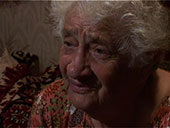
Tatiana Marinina is the sister of Sofia Palatnikova. She was born in 1921 in Teplyk. Her father was a butcher.In the 1930s, she moved to the Lunacharskii collective farm in Crimea. She completed three grades at a Yiddish school in Crimea, and then attended a Russian-language school in Simferopol. After finishing pedagogical training,she worked for two years in an ethnic German village. She survived the war in the Bershad and Raygorod camps. After the war, she worked procuring livestock and later as a German teacher at an evening school. She has a daughter and a son, who lives in Germany.
Seder on a Kolkhoz
Teplyk, Ukraine
Tatiana Marinina of Teplyk, who spent much of the 1930s living on the Lunacharskii collective farm in Crimea with her sister Sofia Palatnikova, recalls how Passover brought the whole collective farm together. Between 1923 and 1938, the American Joint Distribution Committee cooperated with the Soviet government in establishing Jewish colonies throughout Crimea. The Kremlin believed that Jewish settlements would be an effective buffer against ethnic minorities like Germans and Crimean Tatars, who the Kremlin viewed as hostile to Bolshevik power. The Soviet government and the Joint also viewed the project as an opportunity to promote farming among Jews. Dozens of Jewish collective farms were established in the region during these years.

Brukhe Feldman was born in 1938 or 1939 in Bershad. Her father died fighting in the war when she was three years old, and she was brought up by her mother. She spent much of her life working in a furniture factory.
Other Interviews:
Postwar Religious PracticeA Gravestone for My Mother
Kheskele - the Clarinetist
Burial Customs
The Shiva
A Jew Must Eat Matzo
Hunger of 1946
Bershad, Ukraine
The postwar years were difficult years of rebuilding for Jews and non-Jews alike. The year 1946–1947 was the most dire—just as the long process of rebuilding got underway, the region was plagued with a devastating harvest that combined with counter-productive government procurement demands to create an all-out famine. Brukhe Feldman returned to Bershad after the war, and remembered the famine most of all, as her family was forced to seek sustenance in a soup kitchen.
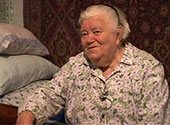
Maria Yakuta was born in 1921 in Teplyk. She grew up with six siblings. Her parents were also born in Teplyk, and her father worked as a hatmaker. She attended a Yiddish school for seven years. Her parents and three siblings were killed in Teplyk during the war.
Other Interviews:
Peeking into the Men's SectionThe Binding of Isaac
The Matzo Bag
"and a goat on a chain"
Eating Sour Mash - the Great Hunger
Sanctification of the Moon
“Der Shtern”
Teplyk, Ukraine
The interwar Soviet shtetl was never completely isolated from the wider world. Residents of small-towns eagerly devoured news from larger cities. High rates of illiteracy combined with the rarity of big-city newspapers, though, meant that for many reading was a collective experience. In this clip, Maria Yakuta paints a picture of a shtetl population intensely interested in the world around them.

Maria Yakuta was born in 1921 in Teplyk. She grew up with six siblings. Her parents were also born in Teplyk, and her father worked as a hatmaker. She attended a Yiddish school for seven years. Her parents and three siblings were killed in Teplyk during the war.
Other Interviews:
"Der Shtern"The Binding of Isaac
The Matzo Bag
"and a goat on a chain"
Eating Sour Mash - the Great Hunger
Sanctification of the Moon
Peeking into the Men’s Section
Teplyk, Ukraine
Women played auxiliary roles in the synagogue service; they did not participate directly in the men’s service, which took place downstairs in the main sanctuary of the synagogue, but rather they held their own services in the women’s section, usually located on the balcony above the main sanctuary. Often the balcony was closed and the women were only able to observe the men’s section through a window. In this clip, Maria Yakuta recalls how the women in the synagogue of Teplyk would listen to the cantor singing below, and peek down to see the men dancing with the Torah scrolls.

Maria Yakuta was born in 1921 in Teplyk. She grew up with six siblings. Her parents were also born in Teplyk, and her father worked as a hatmaker. She attended a Yiddish school for seven years. Her parents and three siblings were killed in Teplyk during the war.
Other Interviews:
"Der Shtern"Peeking into the Men's Section
The Matzo Bag
"and a goat on a chain"
Eating Sour Mash - the Great Hunger
Sanctification of the Moon
The Binding of Isaac
Teplyk, Ukraine
Women were generally unable to acquire a formal Jewish education. Many, like Maria Yakuta, derived their faith and religious identity from biblical stories, which they knew from the Tsene Urene, a popular Yiddish retelling of the Bible. In the spirit of midrash, the book incorporates a variety of non-canonical stories about biblical characters, and explicitly derives moral lessons from the stories. Although the original text dates to the sixteenth-century, versions circulating in the modern period were written in a conversational style, and so were widely accessible. The Tsene Urene was one of the most popular of Jewish writings in the Ashkenazi world well into the twentieth-century. In this clip, Yakuta recalls how her mother would read aloud from the text. Interestingly, the names and life stories of the biblical patriarchs had receded from her memory, but the lessons remained relevant to her daily life. In this clip, she summarizes what it means to be a Jew by telling us the story of Akeydes Yitskhok (the near-sacrifice of Isaac), but she can not recall the names of Abraham or Isaac or even the origins of the story: Yakuta didn’t treat this central story in the Bible as part of a textual tradition, but rather viewed it as an element of folk wisdom. Like many women, and men as well, she knew her biblical stories not from reading the Pentateuch, but rather from retellings of the stories designed to emphasize their moral lessons.

Maria Yakuta was born in 1921 in Teplyk. She grew up with six siblings. Her parents were also born in Teplyk, and her father worked as a hatmaker. She attended a Yiddish school for seven years. Her parents and three siblings were killed in Teplyk during the war.
Other Interviews:
"Der Shtern"Peeking into the Men's Section
The Binding of Isaac
"and a goat on a chain"
Eating Sour Mash - the Great Hunger
Sanctification of the Moon
The Matzo Bag
Teplyk, Ukraine
Passover was the most commonly observed Jewish holiday in the interwar Soviet Union. But few of those we interviewed recalled the meaning of the seder--the ritual meal that forms the centerpiece of the Passover ritual--or the specific details of the Passover Haggadah. Instead, they remember the rituals--the eating of matzo, cleaning the house of bread products, and the peculiarities of the seder ritual. In this clip Maria Yakuta remembers the ornate bag in which the matzo was stored during the seder meal, and how her father reclined during the meal, in accordance with tradition.

Maria Yakuta was born in 1921 in Teplyk. She grew up with six siblings. Her parents were also born in Teplyk, and her father worked as a hatmaker. She attended a Yiddish school for seven years. Her parents and three siblings were killed in Teplyk during the war.
Other Interviews:
"Der Shtern"Peeking into the Men's Section
The Binding of Isaac
The Matzo Bag
Eating Sour Mash - the Great Hunger
Sanctification of the Moon
“and a goat on a chain”
Teplyk, Ukraine
Between 1928 and 1933, the period of the First Five-Year Plan, the Soviet Union underwent a radical transformation from a mixed economy to a planned one: the state outlawed all private capital and launched a massive campaign to promote heavy industry and collectivized farming.
The increased intrusion of the Soviet state into the shtetl was so transformative that people often indicate this break by referring to the post-1933 era as “the Soviet regime” in contrast to the earlier decade, during which the Soviet government had not yet fully infiltrated the
shtetl. This popular periodization reflects the real difficulties the Soviet central government had in establishing full control over the small towns in Ukraine. Prior to what many people refer to as “the Soviet regime” the impact of Soviet institutions and policies was limited. Certainly for those who paid attention to politics, the communist government was instituting numerous changes, but for ordinary folk who struggled on a day-to-day basis to make ends meet, the period before the early 1930s was characterized only by economic insecurity, and at least in the initial revolutionary years, a dizzying array of governments that came and left.
For about fifteen years following the Bolshevik Revolution in faraway Petrograd, the struggle for food security, shelter, and survival continued unabated in small-town Ukraine. It was only during the 1930s that the region began to pull its way out of poverty and slowly transform itself into a modern industrialized region, just in time for a new devastation, whose terrors would completely
surpass the Civil War and pogroms of that earlier era. In Ukraine, collectivization and dekulakization were the most invasive effects of the First Five-Year Plan, radically transforming the Ukrainian countryside.
In addition to the subjugation of the peasantry, though, collectivization unleashed a wave of repression against individuals the state believed facilitated the peasant economy: priests, village elites, private traders, and the petty intelligentsia.34 Repressive policies were replicated in urban centers, where religious functionaries, including rabbis and Jewish elites, were persecuted together with merchants and small shop-owners, who were accused of aiding the kulaks and preventing grain distribution. In short, those who had managed to sustain the economy during the first decade of the Revolution were rewarded for their efforts with arrests and expulsion.
One target of the Teplyk collectivization drive was Maria Yakuta’s uncle, Khotskl. She remembered that Khotskl had a goat, and thus was able to get milk whenever he wanted. This was a luxury in Teplyk during the 1920s, and reason enough for the children to visit Khotskl as often as possible: “He would welcome us with dumplings and milk. It was so delicious.” Khotskl’s goat and the “luxurious” lifestyle he enjoyed with his dumplings and milk attracted the attention of the authorities, who were hunting “kulaks.” Most of Khotskl’s meager wealth came from his small shop: “My mother’s brother had a small shop. There were pencils there and notebooks and herring, kerosene, candles. It was a poor little shop, a little canteen. And he was a pauper with a big family.” But since he personally owned his shop, he was regarded as a speculator, an enemy of the people. As Yakuta explained, “The president of the Jewish government, Stratievski, was given the task of collecting gold from the Jews. He searched my uncle, Khotskl—his name was Khotskl Vitniatski. And he was arrested. He didn’t have any money. He was thrown in prison. He was left there for an entire winter; his beard was overtaken by lice. He barely made it out of there alive. It wasn’t just his money they were after but also that of his brothers. They wanted him to sell out his family.”
Yakuta was indignant that Khotskl was targeted as one of the moneyed elite, when he had so little with which to feed his family: “They were all very poor people. Who were the Jews with money?! Those who had a business with large stores, or large businesses of course. But he just had buckwheat dumplings boiled in milk. And a goat on a chain.”
Source: Jeffrey Veidlinger, In the Shadow of the Shtetl: Small-Town Jewish Life in Soviet Ukraine (Indiana University Press, 2013)

Maria Yakuta was born in 1921 in Teplyk. She grew up with six siblings. Her parents were also born in Teplyk, and her father worked as a hatmaker. She attended a Yiddish school for seven years. Her parents and three siblings were killed in Teplyk during the war.
Other Interviews:
"Der Shtern"Peeking into the Men's Section
The Binding of Isaac
The Matzo Bag
"and a goat on a chain"
Sanctification of the Moon
Eating Sour Mash – the Great Hunger
Teplyk, Ukraine
In 1931, the Soviet central government’s insistence on meeting outrageous procurement quotas and their obstinate refusal to yield to local needs, combined with climactic conditions, created a massive famine in 1932–1933 that left some 2.5 to 3.5 million people dead. Today, many historians believe the famine was manufactured as a deliberate policy to punish the people of Ukraine for their resistance to collectivization. Some view it as a counterpart to the Holocaust and have come to understand it as “the Hidden Holocaust” or the “Unknown Holocaust.” Even the neologism commonly used to describe the 1932–1933 famine, Holodomor—literally, murder by famine—is a semantic counterpart to Holocaust, complete with the same first four letters of the word. While those shtetl Jews who lived through the famine all recall the sufferings that the Jewish community endured, many admit that conditions were worse in the villages. Maria Yakuta recognized that the Jews were tormented with hunger, but her most vivid memory is of the Christians who died near the distillery.

Brukhe Feldman was born in 1938 or 1939 in Bershad. Her father died fighting in the war when she was three years old, and she was brought up by her mother. She spent much of her life working in a furniture factory.
Other Interviews:
Postwar Religious PracticeA Gravestone for My Mother
Hunger of 1946
Burial Customs
The Shiva
A Jew Must Eat Matzo
Kheskele – the Clarinetist
Bershad, Ukraine
Many of those born in the 1920s married and started their families right after the war. Few managed to have full weddings, mostly simply registering at the city hall instead, but the fortunate few were able to celebrate their wedding with a klezmer band. In this clip, Brukhe Feldman remembers attending weddings with klezmer bands in postwar Bershad.

Brukhe Feldman was born in 1938 or 1939 in Bershad. Her father died fighting in the war when she was three years old, and she was brought up by her mother. She spent much of her life working in a furniture factory.
Other Interviews:
Postwar Religious PracticeA Gravestone for My Mother
Hunger of 1946
Kheskele - the Clarinetist
The Shiva
A Jew Must Eat Matzo
Burial Customs
Bershad, Ukraine
After the war, surviving Jews continued to mourn the dead in the Jewish fashion. In this clip, Brukhe Feldman recalls the practice of burial, recalling how the body would be wrapped in a shroud and carried into the cemetery. She remembers, in particular, the practice of avnet, in which a sash is wrapped around the shroud and tied in the form of the Hebrew letter shin. Jewish burial customs were marked as distinctly different than Christian customs, as a result of which Brukhe recalls that the Christians would look on with curiosity. She mentions that they would comment on Jews “running” with the body, likely viewing the custom of carrying the body by hand as bizarre. The clip finishes with Feldman discussing the custom of burning the shoes that the deceased had worn.
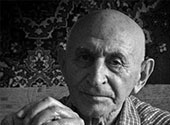
Naum Gaiviker born in 1912 in Khmel’nytskyy (Proskurov). He worked as a barber for 36 years, just like his father. In 1930 he decided to move to Moscow, but had to return to Khmel’nytskyy during the Famine in 1933. He was drafted into the Red Army in 1941 and fought in multiple fronts, including Stalingrad, until the end of the war.
Other Interviews:
The Proskurov Pogrom“I was a courageous lad”
Khmelnytskyy, Ukraine
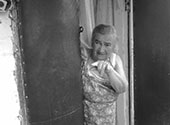
Sofia Geller was born in 1929 in Bratlsav. Her father worked as a coachman before the war. During the war, she evacuated to Central Asia, where she worked in a collective farm. When she returned to Bratslav after the war, she worked in the city council. She is married to Dovid Geller. She and Dovid have two daughters who live in Moscow.
Other Interviews:
Hebrew - the Language of PrayerWith Horse and Wagon to Donbas
Bratslav Matchmaking
"we need to have a wedding!"
Krishmeleyenen
Bratslav, Ukraine
In this clip, Sofia Geller shares what she remembers of the ways a bris was celebrated in prewar Ukraine. In particular, she talks of the krishmeleyenen the custom of boys coming to the parents' house in the days leading up to the bris to recite this prayer as a means of keeping the baby safe. Over time, however, the term came to symbolize any number of customs associated with the bris.

Sofia Geller was born in 1929 in Bratlsav. Her father worked as a coachman before the war. During the war, she evacuated to Central Asia, where she worked in a collective farm. When she returned to Bratslav after the war, she worked in the city council. She is married to Dovid Geller. She and Dovid have two daughters who live in Moscow.
Other Interviews:
KrishmeleyenenWith Horse and Wagon to Donbas
Bratslav Matchmaking
"we need to have a wedding!"
Hebrew – the Language of Prayer
Bratslav, Ukraine
Women in the prewar period were not commonly taught the Hebrew language in which prayers were recited. Only a few Jewish women from the pre-revolutionary generation had acquired some reading knowledge of Hebrew. Some of the younger women whose mothers had acquired rudimentary Hebrew-language skills remembered with pride how their mothers were able to follow along in the Hebrew text. Many women prayed extemporaneously in Yiddish, uttering heartfelt supplications to God. But women with bookish knowledge learned to say their prayers according to the canonical version, in Hebrew, the Holy Tongue. In this clip, Sofia Geller tells us that her mother prayed in Hebrew, but as a young girl Sofia not only didn’t understand the Hebrew, but didn’t even know why her mother was using a strange language. Only now does she understand that her mother was praying in Hebrew.
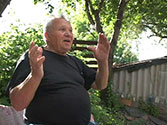
David Geller was born in 1929 in Zhmerynka. During the war he evacuated to Central Asia, first to Tashkent and then to Shymkent. After the war, he returned to Zhmerynka, but soon moved to Kiev, where he worked in a factory. In 1950 he was drafted into the army, served for three years, and then settled in Bratslav, where his wife was from.
Other Interviews:
Evacuation of the CommunistsTashkent-Samarkand-Panjakent
Bratslav Matchmaking
"we need to have a wedding!"
Dovid's Gefilte Fish
“In short, I am a Jew”
Bratslav, Ukraine
The covenant of circumcision has long been regarded as a defining rite of male membership in the Jewish community. According to the biblical book of Genesis, God promised Abraham that he would make of his seed a great nation in return for which Abraham and every child in his “generations” would circumcise their male children as a token of the everlasting covenant. When in 1870 a Jewish physician from Hanover refused to circumcise his son, the event launched a wrenching debate within the German Jewish community over whether one could be accepted as a Jew without being circumcised Although circumcision in the USSR was never officially prohibited, Soviet Yiddish propaganda viciously attacked circumcision as a barbaric rite unbecoming of communist behavior. Nevertheless, the journalist David Meckler, who traveled to Soviet Russia and Ukraine in the mid-1930s, was surprised to find Party members still circumcising their children. Party members were able to excuse themselves from punishment by insisting that their wives had carried out the deed without their consent. It was only later in the decade that circumcising a son became grounds for expulsion. Non-Party members, however, were not subject to the same restrictions and often managed to continue to circumcise their sons until the war. Trained moyels (ritual circumcisers) still practiced in most small towns legally until 1937. Even after the 1937 crackdown and arrest of most of the professional moyels, Jewish physicians could still be counted on to perform the procedure quietly and without witnesses. Dovid Geller also proudly shared with us that he was properly inducted into the Jewish community. His father, however, paid the price of Party membership for this breach of discipline. The term for circumcision that most of those we spoke with employed—the German-component term yidishn rather than the Hebrew- component mole zayn (circumcise)—alludes to a familiarity and intimacy with the ceremony. Its usage as a verb—literally, to make Jewish— also indicates the crucial importance attached to the ceremony as a fulfillment of one’s identity. Source: Jeffrey Veidlinger, In the Shadow of the Shtetl: Small-Town Jewish Life in Soviet Ukraine (Indiana University Press, 2013)

David Geller was born in 1929 in Zhmerynka. During the war he evacuated to Central Asia, first to Tashkent and then to Shymkent. After the war, he returned to Zhmerynka, but soon moved to Kiev, where he worked in a factory. In 1950 he was drafted into the army, served for three years, and then settled in Bratslav, where his wife was from.
Other Interviews:
"In short, I am a Jew"Tashkent-Samarkand-Panjakent
Bratslav Matchmaking
"we need to have a wedding!"
Dovid's Gefilte Fish
Evacuation of the Communists
Bratslav, Ukraine
In the first days of the war, the Soviet government in Moscow established an Evacuation Council, initially headed by Lazar Kaganovich, the Commissar of Transportation who himself had been born and raised in a small shtetl near Kiev. The Council was responsible for coordinating the orderly relocation of critical industrial and consumer infrastructure from the warzone to the Russian interior, where it was imagined industrial output could be preserved with limited interruption. The Council privileged the evacuation of people and entities that were crucial for the military and industrial needs of the state, singling out engineers, workers in factories critical for industrial and military output, youth fit for military service, and state and party elites. Family members of those individuals fitting into these categories were later added to the list. No specific provisions were made for the evacuation of the rest of the civilian population, and at no point was the evacuation of the Jewish population prioritized, despite the mortal danger Jews who fell under German rule faced. The Council also adopted a scorched earth policy, ordering the destruction of all valuable resources that could not be evacuated, so that the enemy—not to mention the civilians caught under enemy rule—would be deprived of even the most basic necessities.
The lack of official sanction and governmental assistance in preparing for evacuation, though, did not stop hundreds of thousands of Jews from fleeing in advance of the German army. Many Jews were able to evacuate as part of the official evacuation because they were represented among the state and party elite or other categories scheduled for evacuation.
As he explains in this clip, Dovid Geller was fortunate that his father was among those privileged to be included in the official evacuation list. As a result, he was able to leave in an orderly fashion from his native Zhmerynka.
Geller believed that the evacuation list included not only communists, but also all the town’s Jews. Despite this common perception that all Jews were scheduled for evacuation, there is no documentary evidence that any government official had a policy to evacuate all Jews.
Source: Jeffrey Veidlinger, In the Shadow of the Shtetl: Small-Town Jewish Life in Soviet Ukraine (Indiana University Press, 2013)

Sofia Geller was born in 1929 in Bratlsav. Her father worked as a coachman before the war. During the war, she evacuated to Central Asia, where she worked in a collective farm. When she returned to Bratslav after the war, she worked in the city council. She is married to Dovid Geller. She and Dovid have two daughters who live in Moscow.
Other Interviews:
KrishmeleyenenHebrew - the Language of Prayer
Bratslav Matchmaking
"we need to have a wedding!"
With Horse and Wagon to Donbas
Bratslav, Ukraine
In the first days of the war, the Soviet government in Moscow established an Evacuation Council, initially headed by Lazar Kaganovich, the Commissar of Transportation who himself had been born and raised in a small shtetl near Kiev. The Council was responsible for coordinating the orderly relocation of critical industrial and consumer infrastructure from the warzone to the Russian interior, where it was imagined industrial output could be preserved with limited interruption. The Council privileged the evacuation of people and entities that were crucial for the military and industrial needs of the state, singling out engineers, workers in factories critical for industrial and military output, youth fit for military service, and state and party elites. Family members of those individuals fitting into these categories were later added to the list. No specific provisions were made for the evacuation of the rest of the civilian population, and at no point was the evacuation of the Jewish population prioritized, despite the mortal danger Jews who fell under German rule faced. The Council also adopted a scorched earth policy, ordering the destruction of all valuable resources that could not be evacuated, so that the enemy—not to mention the civilians caught under enemy rule—would be deprived of even the most basic necessities.
The lack of official sanction and governmental assistance in preparing for evacuation, though, did not stop hundreds of thousands of Jews from fleeing in advance of the German army. Many Jews were able to evacuate as part of the official evacuation because they were represented among the state and party elite or other categories scheduled for evacuation.
These chosen evacuees were often able to bring along family members and even friends on the special trains allocated for this purpose. As word of the atrocities being committed to the west spread, though, most Jews recognized the necessity of flight and took desperate measures to flee. Those who did not make the official list took what they could and headed east. Many Jews had to use their own initiative to evacuate without government assistance. In this clip, Sofia Geller, then Dikkerman, describes how her father, who was a coachman, was able to transport his family out of Bratslav in his wagon, eventually making it to Lugansk.
Outside of immediate danger, those with specialized training were placed in factories to serve the military or industrial mission of the state. Those without industrial or military training were usually put to work on collective farms. As Sofia explains, her family initially in a kolkhoz in Lugansk.
But when the Germans approached Lugansk, the family was forced to evacuate further, traveling in freight trains to Tashkent, and eventually to a town by the Iranian border, where they worked on a kolkhoz for the remainder of the war.
Source: Jeffrey Veidlinger, In the Shadow of the Shtetl: Small-Town Jewish Life in Soviet Ukraine (Indiana University Press, 2013)

David Geller was born in 1929 in Zhmerynka. During the war he evacuated to Central Asia, first to Tashkent and then to Shymkent. After the war, he returned to Zhmerynka, but soon moved to Kiev, where he worked in a factory. In 1950 he was drafted into the army, served for three years, and then settled in Bratslav, where his wife was from.
Other Interviews:
"In short, I am a Jew"Evacuation of the Communists
Bratslav Matchmaking
"we need to have a wedding!"
Dovid's Gefilte Fish
Tashkent-Samarkand-Panjakent
Bratslav, Ukraine
Those who managed to flee in advance of the Germans often found themselves in transit for many months, moving further east in advance of the front and in accordance with government orders. Dovid Geller, who had managed to evacuate from Bratslav explains in this clip how he was first evacuated to Tashkent and then sent further on to Samarkand, where he worked in a collective farm, before he was relocated once again, this time to Panjakent in Tajikistan. Geller’s father was drafted soon thereafter and his mother, who gave birth en route in Dzhambul (Kazakhstan), died in Samarkand, leaving the two older boys with their newborn brother to fend for themselves. Dovid learned how to become a lathe operator and eventually made it to Krasnovodsk (Turkmenistan), on the Caspian Sea. He worked first as a lathe operator, and then, thanks to the intervention of friends of his father, managed to secure work for himself in a cafeteria, where the labor was less physically demanding and where he knew he would have access to food. But the Gellers were among the fortunate few. About two-thirds of those Jews who lived in the territories that eventually came under German rule were unable to evacuate in time. Source: Jeffrey Veidlinger, In the Shadow of the Shtetl: Small-Town Jewish Life in Soviet Ukraine (Indiana University Press, 2013)
